Microtiming in Early Funk
A Microrhythmic Analysis of Fourteen Influential Funk Grooves
Patrick Ainsworth
Beginning with “Cold Sweat” by James Brown, which is arguably the first funk track, this article focuses on the microrhythmic analyses of fourteen influential early funk grooves from the period 1967–1974. All the tracks under scrutiny were created without the use of click tracks, and many were recorded live in the studio, meaning that the determination of microtiming deviations was not straightforward. For this reason, methodologies used for note onset detection, the creation of rhythmic reference grids, and the calculation of microtiming deviations are summarised. These analyses have resulted in an empirical database of over one thousand microtiming deviations. Clear, systematic patterns of microtiming were observed, original and quantifiable data that justified many of the theories previously suggested and discussed in the literature was found, and new information regarding microtiming deviations and patterns was revealed. Sixteenth note swing rhythms were found to be an element of every track investigated (bar one, which was recorded with a drum machine with a straight feel). The degrees of swing varied from imperceptible thorough to overt funk shuffles. Evidence of backbeat delay (the slightly late articulation of beats two and four) was found to be limited. Unless specific musical instructions were being provided by lead vocalists, rhythmic elements of the tracks investigated were not perturbed by vocals. Novel findings were made demonstrating that structural aspects of musical arrangements may be highlighted microrhythmically.
Dieser Artikel untersucht mikrorhythmische Phänomene in vierzehn einflussreichen frühen Funk-Grooves aus dem Zeitraum 1967–1974, beginnend mit »Cold Sweat« von James Brown, dem wohl ersten Funk-Track. Alle untersuchten Tracks wurden ohne die Verwendung von Click-Tracks erstellt, und viele wurden live im Studio aufgenommen, was die Bestimmung von Microtiming-Varianzen nicht einfach macht. Aus diesem Grund werden bisherige Methoden zur Erkennung von Notenanfängen, zur Erstellung von rhythmischen Referenzrastern und zur Berechnung von Microtiming zusammengefasst. Die Analysen haben zu einer Datenbank mit über tausend Microtiming-Varianzen geführt. Es wurden systematische Muster erkannt und quantitative Daten erhoben, die viele der in der bisherigen Literatur vorgeschlagenen und diskutierten Theorien bestätigen; aufgedeckt wurden aber auch neue Erkenntnisse. Swing auf der Ebene der Sechzehntel wurde bis auf eine Ausnahme in allen untersuchten Stücken gefunden; der Grad des Swings variiert von kaum merklichen bis zu offenkundigen Funk-Shuffles. Back beat delay wurde nur in geringem Maße festgestellt. Ein Einfluss der Gesangparts auf die rhythm section ist in der Regel nicht vorhanden. Die neu gewonnenen Erkenntnisse zeigen zudem die Funktion von Microtiming zur Hervorhebung struktureller Aspekte der Arrangements.
Introduction
The importance of early funk and its influence on subsequent genres cannot be over emphasised; it is much discussed by both musicians and academics.[1] In recent decades, extensive sampling has highlighted the infectious nature of this music with many of the sections (or breaks) featuring solo drums and/or percussion extracted from these pieces now forming what has become known as the breakbeat canon.[2]
Close listening, and analysis of discrete musical extracts from funk, and its associated styles, using digitally created waveforms show that performances often demonstrate micro-deviations from a superimposed isochronous rhythmic grid. This so-called “microtiming” or “microrhythm” is considered by many as an essential element of groove in music.[3] According to influential musicians and researchers such as Charles Keil and Vijay Iyer, this concept of groove is central to music genres such as jazz, Latin and funk.[4] In addition to this, Anne Danielsen notes: “the importance of microtiming is almost a given in the field of rhythm research.”[5] Beginning in 1967 with “Cold Sweat” by James Brown, which is arguably the first funk track,[6] this essay will focus on the microrhythmic analyses of influential early funk grooves from the period 1967–1974.
Compared to many musics, funk is often relatively harmonically static, the attention of the listener is held more through the combinations of rhythm than other elements of music. When analysing James Brown’s “Cold Sweat,” Danielsen points out that all the instruments, including the vocals work in a rhythmic manner.[7] Michael Thaut hypothesised: “it seems that in the development of different musical systems, what is given up in complexity on one level enables the attainment of a different complexity on another level, and vice versa.”[8] As funk is often relatively melodically and harmonically simple, the implication is that it should prioritise rhythmical complexity. So, to begin to understand funk, is to begin to understand groove, and to understand groove it is necessary to understand the feel created by the rhythmic features and complexities it contains at both macro and micro levels.
In recent years the amount of qualitative and empirical information regarding microtiming in funk has expanded. However, as highlighted by Richard Ashley and Guilherme Câmara, more data is required in order to increase understanding of groove-based music.[9] To further this process, in this study, fourteen tracks are analysed with reference to microtiming, enabling existing and new qualitative and quantitative findings to be brought together to provide fresh insights in the area.
Background
The beginnings of the analysis of popular music with particular focus on rhythm and microtiming occur in 1966 with the work of Charles Keil and his discussions regarding rhythm in jazz.[10] Keil suggested new approaches for the analysis of music, claiming that traditional methodologies designed for the study of Western Art Music were not appropriate for understanding jazz. Since then, many musicians and academics have discussed the analysis of jazz and popular music focusing on what Keil named “participatory discrepancies,” which he described as some or all of the following: “inflection, articulation, creative tensions, relaxed dynamisms and semiconscious or unconscious slightly out of syncnesses.”[11] Many of these discussions have an emphasis on microtiming to the extent that Keil’s “participatory discrepancies” are now generally thought of as microtiming deviations.[12]
The earliest empirical measurements of microtiming deviations in jazz were implemented in the late 1980s and early 1990s.[13] Many of these early studies focused on the varying degrees of swing employed by jazz musicians.[14] In 1995, Josef Prögler expanded on Keil’s theories through the analysis of recordings and concluded: “participatory discrepancies are observable at the subsyntax level and they can be precisely measured.”[15]
Alongside the above analyses of microtiming in Jazz, Jeff Bilmes[16] and Olavo Alén[17] studied timing deviations in Cuban music. From timing deviation information gained from performances given by the Cuban percussion group Los Munequitos de Matanzas, Bilmes was able to demonstrate systematic patterns of microtiming.[18] In his analysis of the Cuban genre Tumba Francesa, Alén also observed microtiming patterns that deviated from a superimposed metronomic grid.
Although limited in empirical research, Vijay Iyer’s 1998 doctoral dissertation coalesced much of the previous research into microtiming from the late 1960s to the mid 1990s. He extended the work of theorists such as Keil to provide a robust foundation for the understanding and analysis of genres other than Western Art Music with a particular focus on rhythm and groove-based African and African American musics. In addition to discussions regarding degrees of swing, Iyer also focused on backbeat delay (the late articulation of attacks on beats two and four in a four-four meter).
Central to Iyer’s thesis is the theory of embodied cognition in Western African and African American musics, suggesting that rhythm perception and production involves a whole-body experience and that the structure of rhythm-based music incorporates this embodiment. Furthermore, he explained that, as rhythm perception is an embodied activity, listening to music is an active process rather than a straightforward passive transfer from performer to listener.[19]
Peter Freeman and Lachlan Lacey[20] examined the microtiming deviations contained within the drum break from James Brown’s “Funky Drummer.” Systematic patterns of microtiming were found throughout the eight bar break. In her highly detailed book, Anne Danielsen[21] provided a great deal of insightful information regarding funk rhythms generally on the macro level, but also on the micro level, though did not analyse microtiming deviations empirically. In addition to identifying note onsets that are played early, or late with reference to a superimposed, quantised grid, Danielsen suggested that these microtiming deviations might contribute to the overall funk groove. Danielsen also identified that funk sixteenth notes can contain degrees of swing. Evidence of degrees of sixteenth note swing in funk was also found by Timothy Hughes[22] in his study of Stevie Wonder’s “Superstition” and by Esa Räsänen et al. in Michael McDonald’s “I Keep Forgettin’.”[23] Sixteenth note swing was the focus of studies by Guilherme Câmara[24] and Andrew Frane.[25] Both studies showed that varying degrees of sixteenth note swing are frequently present in funk.
As shown above, there is a growing body of both qualitative and quantitative research into microtiming/microrhythm in jazz, Latin music and funk, much of which appears to contain the assumption that microtiming enhances the quality of groove for the listener. Despite this, only a relatively small, but growing number of studies (eighteen in total) have been implemented that attempt to analyse and evaluate listener reactions to music containing microtiming deviations.[26] Of these, nine show some evidence that microtiming might enhance groove (albeit limited in most cases)[27] and nine show that it does not.[28] Of the studies that do show that microtiming may enhance groove, only four have a particular focus on funk or related styles.[29]
The mixed results summarised above could be caused by the fact that investigating the effects of music on listeners (including possible enhancement of groove created by microtiming) is fraught with issues including the following:
Stimuli (particularly when created using synthesised, MIDI or sampled sounds) may sound artificial.
Listening environments are difficult to control, particularly when conducting online studies.
Listening tasks can become fatiguing.
The experience of groove maybe multifaceted and not just based on rhythm and duration.
It may be impossible to recreate the audio nuances of original recordings.
Measurement of the responses of subjects to musical stimuli is challenging.
For many of the above studies, listeners are asked to rate the quality of grooves,[30] however, a few researchers have employed the measurement of physical reactions to music such as body movement[31] or pupil dilation.[32] It is worthy of note that the two studies that employed the measurement of body movement both produced some evidence that microtiming might enhance listeners’ experience of groove. Although not a part of this study, further listening experiments utilising innovative methodologies are indicated to shed greater light on the possible effects of microtiming on groove quality. This study is not designed to investigate whether microtiming enhances funk grooves, but to simply observe whether patterns are present, relate them to the findings of previous research and to propose possible new theories for their existence.
Selection of Materials
Various criteria for selection of material to be examined were employed. It was necessary to ensure that all tracks chosen conformed to the funk genre, or its associated styles. Guilherme Câmara identified that funk rhythms often contain a sixteenth note density referent and have a tendency towards alternative pulses within the main 4/4 rhythm (syncopation and/or counter rhythm).[33] All the tracks analysed include these features. It seemed logical to select tracks which had already been discussed by researchers in the field, particularly when qualitative information provided by these academics could be enriched by quantitative microtiming data from this study. It was imperative to select tracks from which microtiming data could be easily extracted. For this reason, many of the excerpts analysed were drawn from the breakbeat canon[34] as these tracks contain drum solos with limited simultaneous onsets. Original recordings rather than breakbeat libraries were used as the source material to guarantee that the excerpts had not been subject to any editing/sonic manipulation post initial release. Other songs involving drum/percussion breaks, or clearly discernible note onsets (generally on drums, but across ensembles if possible) were also analysed. Alexander Stewart emphasised the importance of the impact of music from New Orleans on the development of funk, and in particular, the music of James Brown,[35] this influence was taken into consideration when selecting the sample of songs to be analysed. In a similar manner to Andrew Frane and Mitchell Ohriner,[36] it was possible to use external ratings of the influence and widespread appeal of some of the tracks to be analysed using information from whosampled.com. This is an online database of music sampling information and contains a popularity chart of the most sampled beats (many from the breakbeat canon). This chart could be cross-referenced with the other selection criteria to ensure that the tracks conformed to funk stylistic characteristics. The focus of the analyses was on the period 1967 to 1974. 1967 was chosen as the start date as this was the release year of “Cold Sweat” by James Brown. The end date 1974 was chosen simply to limit the already large pool of choice and to focus on relatively early funk.
There are obvious limitations to the information that can be derived from the selection of tracks and the corresponding analyses. Although it took many months to complete the analyses and a great deal of data was extracted, the sample is still relatively small and so cannot be seen as fully representative of funk from 1967–1974. Choice was often restricted by the availability of tracks with clearly discernible note onsets. Despite the use of the above criteria, a human element was still involved in the selection process. Some songs contained long sections with discernible onsets and some songs contained much shorter sections from which microtiming information could be extracted, so the number of usable bars in each piece varied significantly. In addition to this, for some tracks, onsets were perceptible across complete ensembles, in others, it was only possible to analyse information from drums and/or percussion. Many of these limitations are inevitable when working with live and multi-track recordings from this period and simply have to be accepted, but also noted. The focus of the analyses was on sections of songs containing as few instruments as possible (often drum breaks), as note onsets in excerpts containing larger numbers of instruments were difficult to discern from waveforms and spectrograms. Table 1 provides an overview of the selected songs.
Table 1: Overview of track excerpts selected for analysis
Audio Example 1: “Cold Sweat,” drum/bass break
Audio Example 2: “Sing a Simple Song,” drum break
Audio Example 3: “Amen Brother,” drum break
Audio Example 4: “Cissy Strut,” bars 3–8
Audio Example 5a: “Handclapping Song,” bars 13–15
Audio Example 5b: “Handclapping Song,” bars 25–27
Audio Example 6: “Funky Drummer,” drum break
Audio Example 7a: “Sex Machine,” bars 3–8, drum
Audio Example 7b: “Sex Machine,” bars 3–8, bass
Audio Example 7c: “Sex Machine,” bars 3–8, guitar
Audio Example 7d: “Sex Machine,” bars 3–8, vocal
Audio Example 8a: “Super Bad,” bars 4–7, drum
Audio Example 8b: “Super Bad,” bars 4–7, bass
Audio Example 8c: “Super Bad,” bars 4–7, vocal
Audio Example 9a: “Think (About It),” bar 23
Audio Example 9b: “Think (About It),” bar 29
Audio Example 9c: “Think (About It),” bar 42
Audio Example 9d: “Think (About It),” bar 48
Audio Example 10: “Impeach the President,” drum break
Audio Example 11: “Apache,” drum break
Audio Example 12: “In Time,” drum break
Audio Example 13: “It’s a New Day,” drum break
Audio Example 14: “Funky President,” drum break
Methodology
Accuracy of Digitally Produced Waveforms and Spectrograms
In order to measure and analyse the microtiming deviations contained within the excerpts of music, waveforms and spectrograms created in Avid Pro Tools and Sonic Visualiser[37] were utilised. The accuracy of visual information created by these software packages and the temporal sensitivity of listeners needs to be considered to justify findings.
The default view for waveforms created by Avid Pro Tools is “peak mode” which was employed in all the analyses. In peak mode waveforms are calculated to the temporal accuracy of one sample. The sample rate used in this study was 44.1 kHz giving a sample length of 0.0227 milliseconds (ms). Deviations of 20–30 ms are likely to be detected by listeners[38] and deviations of 0–10 ms can be detected by experienced musicians,[39] but rhythmic acuity for deviations lower than this can only be demonstrated in the lab.[40] For this reason, all microtiming intervals considered in this study were greater than or equal to 1 ms, so waveforms created by Pro Tools are sufficiently finely sliced for temporal analysis. In order to create a spectrogram, Sonic Visualiser cuts a sound into temporal blocks or windows. To gain clear information regarding frequencies, the default window length (1024 samples) and shape[41] were employed leading to windows with lengths of approximately 23 ms at sample the rate of 44.1 kHz. Since microtiming deviations of less than 20 ms were considered in this study, waveforms rather than spectrograms were used primarily to determine note onsets. Despite its limited accuracy, the information derived from spectrograms was still valuable since the frequency content of sounds could be used to help verify which timbres, and therefore instruments, were contributing to the whole. This data was particularly helpful when the time intervals between adjacent note onsets were very small (for example, a kick drum and a hi-hat occurring almost simultaneously) as the first attack often obscured the next. The spectral content could help determine the order of note onsets.
Note Onset Determination
In order to obtain useful information from musical recordings, and calculate and analyse microtiming deviations, it is imperative to determine where listeners actually perceive note onsets in relation to their physical onsets (the first positive or negative rise of a sound from 0 dB on the waveform). This is defined as the “perceptual attack time” (PAT). Many studies have shown that the position of a sound’s PAT is not exact, but based on probability.[42] The most relevant findings to this study are those related to sounds with short onsets as most sounds in funk grooves have rapid rise times (cymbals, drums and percussive guitar attacks), for sounds such as these, subjects often experienced PATs within a few milliseconds of the physical onsets.[43] The only sounds with slightly longer rise times involved in this study are those generated by the electric bass guitar (up to 5 ms). For this reason, a small-scale study involving the synchronisation of repeating loops of pairs of different sounds by expert listeners was implemented. Similar paradigms have been employed in previous PAT studies.[44] The rise times of the sounds involved varied from 0.02 ms (hi-hat) to 4 ms (electric bass). Findings from this small-scale study showed that highly skilled musicians/producers could synchronise notes with small, but different attack times often perfectly, and frequently within less than six milliseconds of each other. This synchronisation ability was irrespective of the spectral content of the sounds. The combination of previous investigations and the findings from the small-scale study justify the use of physical onsets as referent points. This methodology was also employed by Guilherme Câmara[45] and is justified by Mark Doffman.[46]
As stated above, waveforms derived from Pro Tools were used to determine physical onsets. This was a straightforward process provided that individual onsets were visually discernible. For onsets occurring almost simultaneously, the process was not so simple. In some cases, individual onsets could also be identified using a combination of waveforms and spectrograms. An example of this issue was found with “Handclapping Song.” Beginning at bar 13 (approx. 32”), there is a four bar drum break. For the cleanest note onsets (avoiding all but percussion instruments) bars 14 and 15 were examined. Figure 1 shows an excerpt of a waveform from the first beat of bar 14 extracted from this track. The first kick of each bar is accompanied by a handclap making determination of beat one difficult due to the closeness of the kick drum and clap onsets. The red arrow shows the possible error (approximately 13 ms) in defining the exact position of the kick onset.
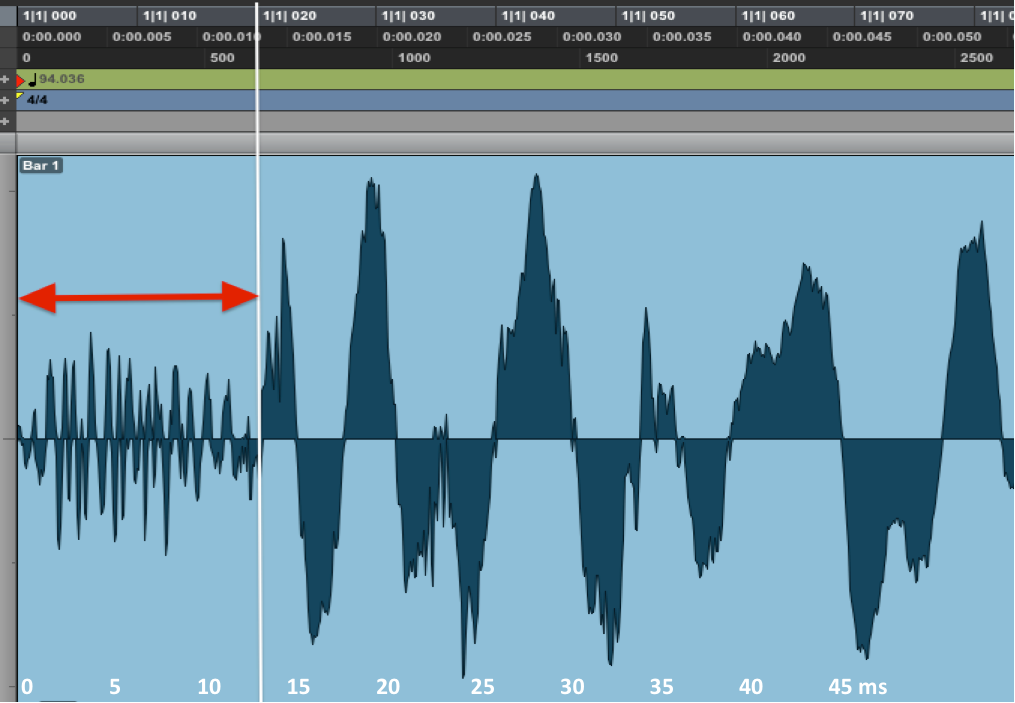
Figure 1: Waveform (from Pro Tools) of the first beat of bar 14 extracted from “Handclapping Song”
Further examination using Sonic Visualiser to display the spectrogram and waveform in the same timescale (see Figure 2) showed that the low amplitude signal was due to the handclap and the kick drum onset occurred approximately 13 ms later. The intense frequency groupings (shown in red) between 600 Hz and 2500 Hz show the clap (the blue shaded area of the waveform). The kick onset begins at about 13 ms shown by the intense frequencies between 50 Hz and 300 Hz.
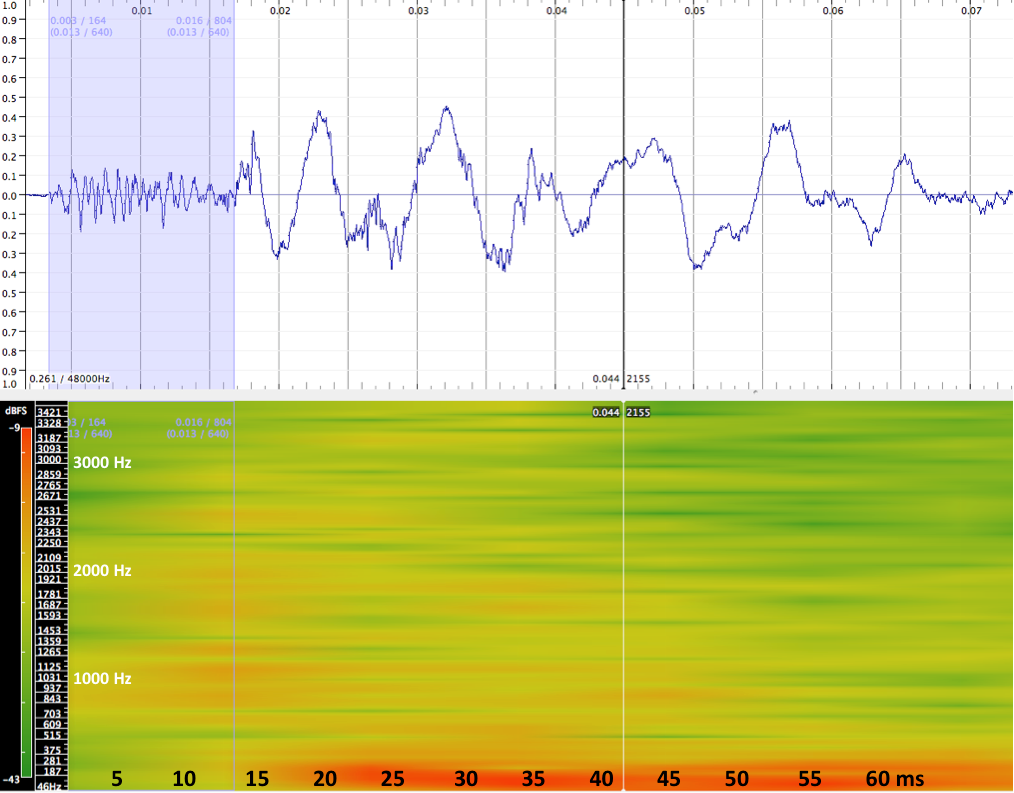
Figure 2: Waveform with spectrogram below from the first beat of bar 14 extracted from “Handclapping Song”
Combining the frequency content from the spectrogram and the accuracy of waveforms enabled precise determination of the kick onset.
In cases where note onset determination proved difficult using the above methods, clean onsets were extracted and aligned with areas of the waveform containing audible evidence of similar onsets. This method was particularly helpful when locating the onsets of instruments containing predominantly lower frequencies in excerpts containing larger numbers of instruments. Figure 3 shows an area of a waveform from “Cissy Strut” containing a kick drum hit; this onset is partially obscured by notes played on the guitar, bass, and organ. Figure 4 shows the same excerpt (coloured pink) with a clean kick onset (coloured green) extracted from elsewhere in the piece and aligned with the obscured onset enabling determination of the point of attack of the obscured kick drum.

Figure 3: Waveform extracted from “Cissy Strut” showing an obscured kick drum onset
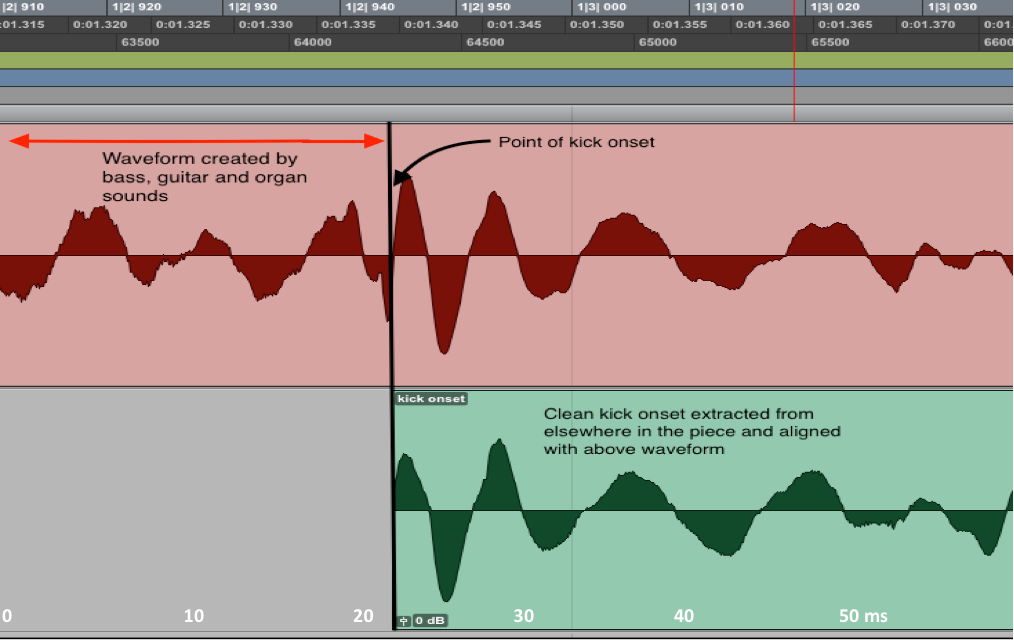
Figure 4: Waveform from Figure 3 showing a clean kick onset (green) from elsewhere in the piece, aligned with the obscured kick drum onset (pink)
For attacks of brighter instruments such as hi-hats/cymbals occurring after sounds comprising lower frequencies, the method used by Matthew Butterfield[47] was implemented. A sound containing predominantly lower frequencies often has a smooth, high amplitude waveform with long periods; the brighter instrument has a more spikey, low amplitude waveform with much shorter periods. The attack of the brighter instrument causes the waveform to become “fuzzy” making the onset clearly discernible. This can be seen in Figure 5, which shows kick onset followed by a hi-hat (extracted from “Funky Drummer”).

Figure 5: Waveform from “Funky Drummer” showing a hi-hat onset occurring after a kick drum onset
Unfortunately, in many cases, separating onsets proved impossible: Figure 6 shows a combined onset of a snare drum and hi-hat. Although these two parts of the kit are clearly audible, the snare contains such a broad range of frequencies that the hi-hat onset is completely obscured. This made measurement of any microtiming deviations between the two attacks impossible.
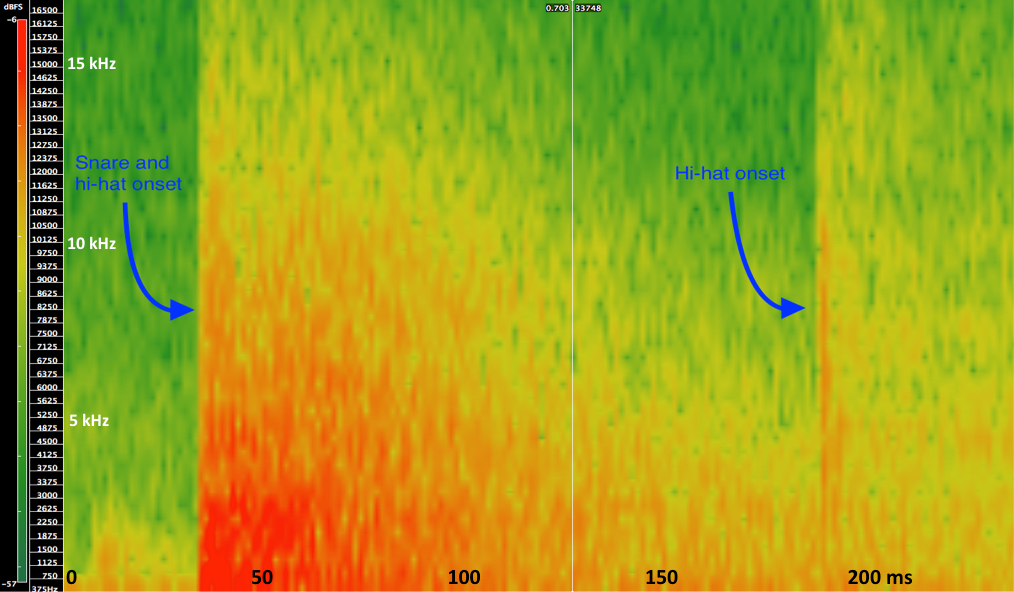
Figure 6: Spectrogram extracted from the second bar of James Brown’s “Funky Drummer”, showing a sixteenth note onset comprising the snare drum and hi-hat where the hi-hat is visually obscured by the snare. The adjacent hi-hat onset is also shown.
Determination of the “Grid” and Calculation of Microtiming Deviations
Entire pieces were imported into Pro Tools and were auditioned closely to find the sections containing the cleanest note onsets; these sections were then clipped by eye from the waveforms using Pro Tools editing functions. The precise points at which bars began and ended could be easily determined if just one onset or simultaneous onsets occurred on the first beat. Where close onsets occurred such as in “Handclapping Song,” human judgement could not be avoided: one of the onsets had to be chosen as the referent point. For consistency, the same instrument was used to define beginnings and ends of bars throughout the extract in question. For “Handclapping Song,” it appears that the clap is played early relative to the kick drum. For this reason, in order to analyse the microtiming deviations, a two-bar excerpt was created with the kick onset as the beginning of bar 14, beat 1 and the end of bar 15, beat 4. Thus, the early clap appears at the end of the clip (see Figure 7). Once extracted, the exact tempo of each excerpt was determined using the “beat detective” function in Pro Tools, leading to the automatic superimposition of an isochronous sixteenth note grid over the waveform (see again Figure 7).[48]

Figure 7: Waveform showing bars 14 and 15 of “Handclapping Song” with isochronous sixteenth note gridlines. The clap is clearly visible at the end of the clip. The gap between the two red arrowheads shows a microtiming deviation.
Following this, the microtiming deviations of these note onsets from the grid were calculated by eye to the nearest millisecond by zooming in and using the Pro Tools ruler. Individual bar lengths were examined to determine whether tempo changes were present. If tempo variations were not found, bars could be examined in groups, if tempo changes were present, individual bars were analysed separately. The maximum length of sections analysed was just two bars in order to minimise the effect of tempo variations (for more details see Table 1). Unless otherwise stated, the kick drum onset was used as the referent point for the beginning of each bar and drum rather than cymbal onsets were prioritised as drum hits often obscured cymbals (including hi-hats). At this point it is worth noting that the human choice of the use of beat 1 as the start and end point of each one or two bar excerpts is potentially flawed. Beat detective simply creates a time ruler, dividing each clip into sixteenth note portions and does not allow for tempo changes within each excerpt. In addition to this, the findings of Andrew Frane[49] suggest that beat one in funk, may often occur relatively early, or as described by Anne Danielsen: “the One should be played on top [of the beat].”[50] If beat one is articulated early, using it as the start point of each excerpt will skew the following microtiming deviations, making them appear later in transcription than might be perceived by the listener. Despite these issues, the findings resulting from the above processes do show the relative positions of note attacks and from these patterns of microtiming deviations can be discerned.
To present as much detailed information as possible, note onsets and microtiming deviations were presented using the “time unit box system” (TUBS), rather than staff notation, as recommended by Rowan Oliver.[51] TUBS is particularly effective for analysis of rhythm as every sixteenth note subdivision is graphically represented and it enables the reader to easily view timing asynchronies between onsets that would appear simultaneous when viewed using standard drum notation. In addition, it allows the reader to discern patterns in each repeating groove iteration (see Table 2 for an example; all remaining transcriptions are shown in the Appendix).
Table 2: The Winstons, “Amen Brother,” drum break: Rowan Oliver’s TUBS transcription[52] with microtiming deviations added
The deviations were also transferred to Microsoft Excel in order to create straight lined scatter graphs to examine the excerpts for patterns of microtiming as presented by Andrew McGuiness[53] in his analysis of “Funky Drummer.” Coloured lines on these scatter graphs show the patterns of deviations for each groove iteration with a heavier black line showing the mean deviation for all iterations (see Figure 8 for an example).
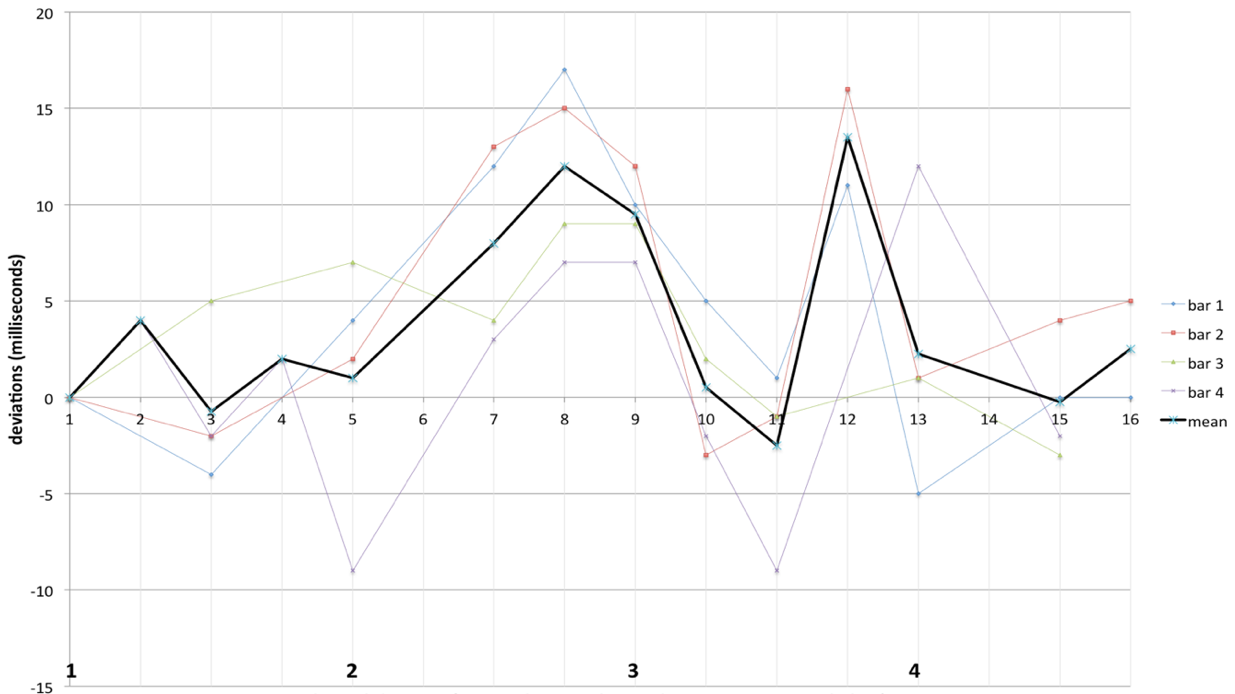
Figure 8: The Winstons, “Amen Brother,” drum break: straight lined scatter graph showing microtiming deviations occurring on the drum kit (data points are shown on each line)
Findings and Discussion
Elements of systematic microtiming were revealed in all the songs analysed except for “In Time” by Sly and the Family Stone, in which the drummer’s stated aim was to play as closely as possible to the sixteenth note grid created by the drum machine that underpinned rhythmic aspects of the track.[54] Many of the findings that emerged during the process of analyses were related to sixteenth note swing, backbeat delay or perturbation by vocals. These aspects of microrhythm have already been examined in some depth by researchers.[55] Apart from some findings regarding backbeat delay, in general, the results of this study aligned with, and reinforced, previous findings in the field. In addition, new observations focused on the relationship between microtiming and structural aspects of music were made. Findings are discussed below in relation to existing theories, and new information regarding microtiming deviations and patterns is highlighted.
Sixteenth Note Swing
Sixteenth note swing is often a feature of popular music; perceptible, barely perceptible, and imperceptible levels of swing have been observed in funk and have been studied in depth by Stewart, Câmara and Frane.[56] There is a great deal of crossover between this study and the studies by Câmara and Frane (see Tables 1 and 3). Degrees of sixteenth note swing are discussed in the analyses below using ratios where 1:1 represents zero swing and 2:1 represents triplet swing. Swing ratios were calculated in a similar manner to Frane[57] by comparing the inter-onset interval (IOI) between an on beat sixteenth note and the following off beat sixteenth and the next IOI between the off beat sixteenth and the following on beat. On the few occasions where off beat sixteenths occurred without a following on beat attack, the position of the subdivision on the superimposed isochronous grid was used as the on beat (the same methodology was used by Câmara[58]). Swing ratios can be calculable at up to eight positions in each bar, leading to large datasets. For this reason, in general, mean swing ratios are discussed. The perception of swing can also be affected by tempo and the number of off beat onsets in the bar (swing density), so both tempo and swing density were considered. For sixteenth notes in a 4/4 metre, swing densities were calculated as percentages in a similar manner to Frane as follows:
Câmara and Frane suggested that swing becomes discernible at ratios somewhere between 1.1:1 and 1.2:1.[59] In a later study, Frane and Ladan Shams’ findings from an experiment considering tempo, swing ratio, and musical experience confirmed this result for drummers at high swing densities (87.5 %) but showed that at lower swing densities (37.5 %) and higher tempos, swing was less perceptible. Non-drummers were even less able to detect swing particularly at high tempos and low densities. Frane and Shams’ findings were used to determine swing salience in the song analyses.[60]
From the findings of Stewart, Câmara and Frane,[61] varying degrees of swing were expected: according to Câmara, swing is a universal feature of funk.[62] This aligns with the findings of all the analyses: evidence of swing was detected in every track analysed except “In Time,” in which the drummer was playing to a drum machine and, by his own admission, wished to perform perfectly with the machine, so was forced to play straight sixteenths (see above). The straight line scatter graphs created for every track (except “In Time”) show the characteristic zig zags of swing, demonstrating that the off beat sixteenth notes occurred relatively late compared to those on the beat or on eighth note subdivisions. For some tracks such as “Cold Sweat” and “Funky Drummer,” swing was found to be imperceptible or barely perceptible, for others with more pronounced zig zags, swing was clearly discernible. Figure 9 shows a comparison of scatter graphs for three tracks with different degrees of swing (“Funky Drummer”, “Cissy Strut” and “Funky President”). At this point, it is worth noting that the majority of the deviations for “Funky Drummer” are positive (or late). This may be because beat one was used as the reference point for the beginning of each groove iteration (see above), but the drummer was actually performing this beat early causing following attacks to appear relatively late. This potential methodological limitation is discussed below.
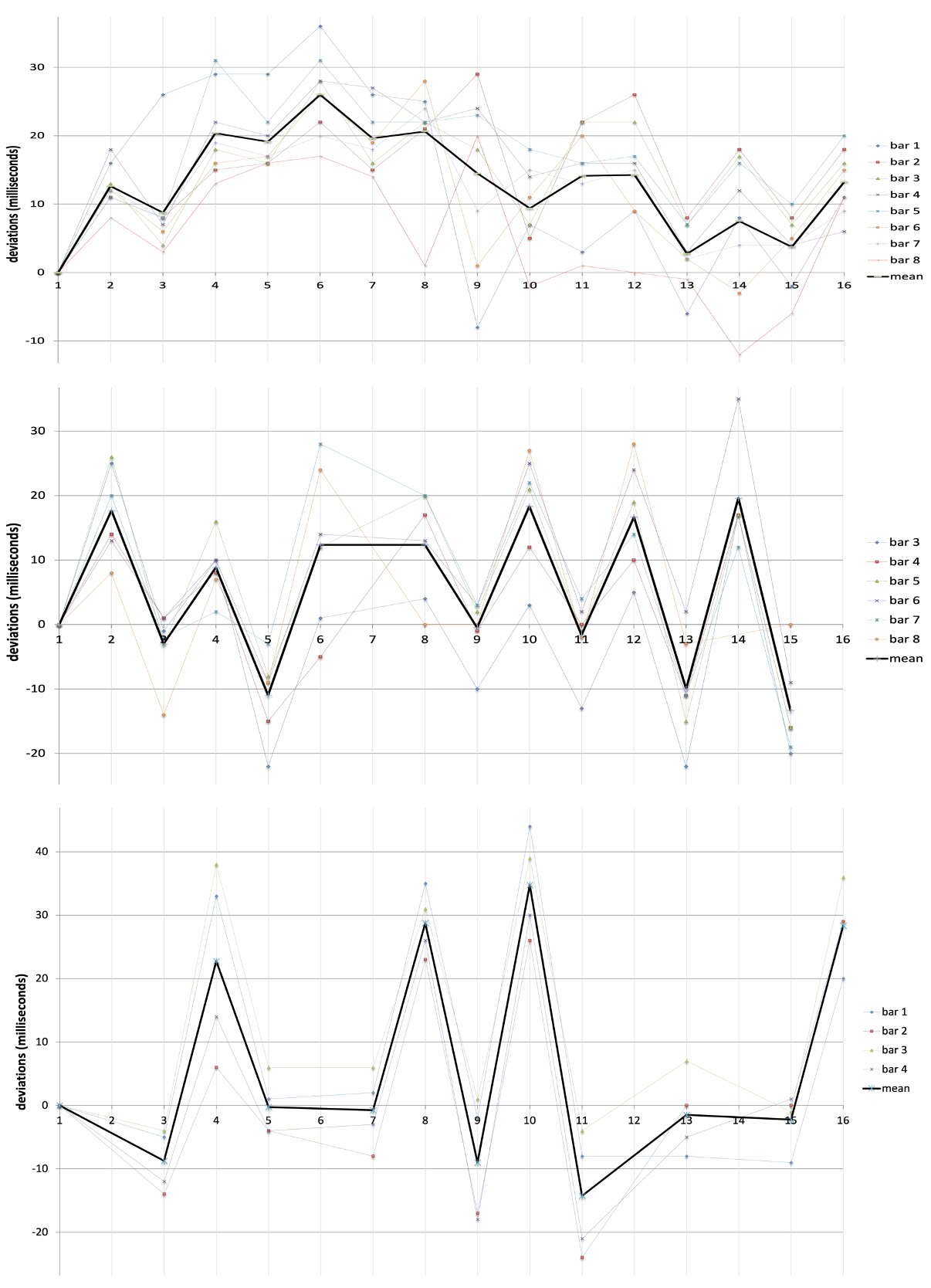
Figure 9: Straight lined scatter graphs showing different degrees of swing in “Funky Drummer” (swing ratio 1.07:1, barely perceptible or imperceptible),[63] “Cissy Strut” (swing ratio 1.3:1, just perceptible)[64] and “Funky President” (swing ratio 1.6:1, clearly perceptible)[65]
Table 3 is a summary of the swing densities and the mean swing ratios calculated from the drums in each track; possible swing salience based on the findings of Frane and Shams is also included.[66] In addition to this, the findings of Câmara and Frane are also shown for comparison. In general, all findings align closely; however, there are minor discrepancies as Câmara’s calculations were based on all instruments (whereas the findings here are focused on drums) and Frane generally analysed fewer bars.
Table 3: Swing ratios, calculated from the drums, of the tracks analysed (note: bold lines group tracks with the same drummer together)
Digging deeper into the findings from the analyses reveals a great deal more about swing in funk. Some of the detail regarding degrees of swing echoes research focused on jazz. As shown by Mark Ellis for jazz,[67] the swing ratios in funk differ from song to song. The ratios in this study vary from 1.07:1 (“Cold Sweat” and “Funky Drummer”) to 1.8:1 (“Papa Was Too”). However, unlike jazz, none of the ratios are equal to, or greater than triplet swing (2:1) as measured by Richard Rose.[68] It seems that funk drummers like to play time somewhere between regular sixteenth notes and sixteenth triplets as noted by Jim Payne when describing John Jabo Starks’ (one of James Brown’s drummers) playing.[69] Freeman and Lacey were able to identify jazz drummers (Gene Krupa and Buddy Rich) through their swing ratios.[70] This may also be the case for funk: the ratios for “Cold Sweat” and “Funky Drummer,” both played by Clyde Stubblefield, are identical (1.07:1); the same applies for Zigaboo Modeliste’s drumming in “Cissy Strut” and “Handclapping Song” where both ratios are 1.3:1. It is possible that funk drummers might display a swing ratio fingerprint in a similar manner to jazz musicians.
Unlike jazz, imperceptible or barely discernible swing was found to be a feature of five of the fourteen songs analysed (“Cold Sweat,” “Funky Drummer,” “Super Bad,” “Amen Brother,” “Apache”). It could be possible that, even though not overt, these outwardly undetectable degrees of swing do have some effect on the listener and might enhance groove quality; this theory is supported by Roger Linn.[71] Swing, whether easily detectable, or barely discernible, appears to be an important feature of many funk grooves, however, as shown by some of the lower swing densities found (see Table 3), swing in funk is not always produced by continuous long-short pairs of notes as is often the case in jazz, but can created through timing differences in individual note pairs.
Backbeat Delay
One of the main expectations in the findings of these analyses was quantifiable evidence of backbeat delay (the slightly late articulation of beats two and four, usually on the snare drum). Backbeat delay appears to be an almost universally accepted feature of African American music such as jazz and funk; Iyer dedicated a whole section of his 1998 thesis to the subject and also suggested that backbeat delay might be in built into the human organism: a result of the motor system.[72] To date, some empirical evidence of backbeat delay in funk and its related styles has been found, but not a significant amount. Ives Chor found some evidence in the piano parts of Afro-Cuban styles.[73] In his analyses of The Loop Loft (a commercially available collection of loops created by world class musicians), Fred Hosken provided some evidence of late snare drum onsets on beats 2 and 4 of the bar.[74] However, Matthew Butterfield countered Vijay Iyer’s argument regarding the motor system, concluding that backbeat delay is actually a chosen expressive rhythmic feature.[75] Based on the songs analysed in this chapter, it appears that Butterfield’s conclusions may be a more accurate representation: backbeat delay does not appear to be a significant feature, and perhaps, contrary to expectation, should not be considered as part of the codification of funk music.
Of the fourteen songs analysed, seven contain elements of backbeat delay (“Funky Drummer,” “Sex Machine,” “Super Bad,” “Think (About It),” “Handclapping Song,” “Impeach the President,” “It’s a New Day”). However, the backbeat delay for these songs is at low levels that might only just be noticeable if Anders Friberg and Johan Sundberg’s findings focusing on just noticeable differences (JNDs) in IOIs are applied.[76] Five songs contain levels that are imperceptible (“Cold Sweat,” “Amen Brother,” “Papa Was Too,” “Apache,” “Sing a Simple Song”). Two contain none (“In Time,” “Funky President”) and four contain the opposite of backbeat delay (“Cold Sweat,” “Funky Drummer,” “Think (About It),” “Cissy Strut”). It is also noteworthy, that three of the songs analysed (“Amen Brother,” “Think (About It),” “Funky Drummer”) contain relatively early, and “snappy” sounding snare hits on the fourth beat of each bar. In their analysis of “Funky Drummer,” Freeman and Lacey showed that the mean deviation on beat two is relatively late, however, based on the analysis in this study, this may not be an indication of backbeat delay.[77]
Based on these findings, it appears that Butterfield’s argument may be closer to the truth: backbeat delay can be present, but it appears to be a choice. Table 4 is a summary of backbeat delay for each track analysed.
Table 4: Backbeat delay of the tracks analysed (note: bold lines group tracks with the same drummer together)
Perturbations by Vocals
Three of the tracks analysed show some element of microrhythmic influence created by the performance of the vocalist: “Cold Sweat,” “Funky Drummer,” and “Think (About It).” This is partly due to the fact that many of the excerpts contain minimal or no vocals. As shown below, despite expectations (especially involving James Brown’s music), vocalists have limited rhythmic influence in these tracks.
Anybody who has witnessed the vocal energy and physicality of a James Brown performance would assume that his verbalisations and movements would be likely to perturb the rhythm section. Brown was a fearsome bandleader who allegedly fined musicians for errors.[78] However, based on the analyses of the James Brown songs, it appears that, when performing over grooves with the band, he acts as part of the band rather than the leader. In “Cold Sweat,” “Funky Drummer,” “Sex Machine” and “Super Bad,” Brown’s vocal interjections do not appear to perturb the rhythm of the drums in any significant manner. In “Funky Drummer,” Brown clearly praises the rhythmic quality of the groove created by Clyde Stubblefield on drums. Perhaps, despite his appearance as a martinet, he, and all the musicians involved, prioritised the communal rhythm of the groove above any band hierarchy; Brown’s vocals are simply another part of the band. There are occasional exceptions to this in “Cold Sweat” and “Funky Drummer,” but only when Brown is providing musical instructions such as count offs.
In “Think (About It),” the drums appear to be influenced by a guitar and bass figure that lands with an accent on beat four; this is followed by a catchy vocal hook which ends on the fourth beat of the next bar. Both of these fourth beats are timed relatively early by the drummer (Jon Jabo Starks) and feature an accented, snappy snare hit. So here, riffs create the perturbation: the first instrumental, and the second vocal. So, like Brown’s music, the vocalist is acting as an equal part of the band, rather than a leader (see Figures 14 and 15).
This equal division of musical responsibility in funk is summarised in Anne Danielsen’s comparison of James Brown’s earlier proto-funk song, “Papa’s Got a Brand New Bag” with his first funk tune, “Cold Sweat.” “Papa’s Got a Brand New Bag” has a clear division of labour with the vocals on top whereas “Cold Sweat” has all of the instruments, including the vocals, working in the same way.[79] Despite the possible theatrical performance of the funk bandleader, perhaps he or she has no more rhythmic influence on funk grooves than the other band members.
Structural Aspects
David Wessel and Matthew Wright observed that drummers have extremely precise control of the temporal accuracy of flams (close to 1 ms),[80] and the rhythmic precision of jazz drummers was observed by Henkjan Honing and W. Bas De Haas.[81] It was anticipated that rhythmic accuracy would be a feature of the findings. This expectation was fulfilled in many of the analyses in this chapter, however, one of the most striking findings is that drummers frequently repeat patterns of deviations within just a few milliseconds of each other. Not only was a high level of rhythmic acuity observed, but also an impressive level of rhythmic memory. A particularly good example of this is shown in two adjacent bars of the four bars analysed from “Amen Brother” by the Winstons (see Figure 10). The first two bars of this break are shown as they are identical; the pattern changes in the following two bars (see Table 2 and Figure 8).
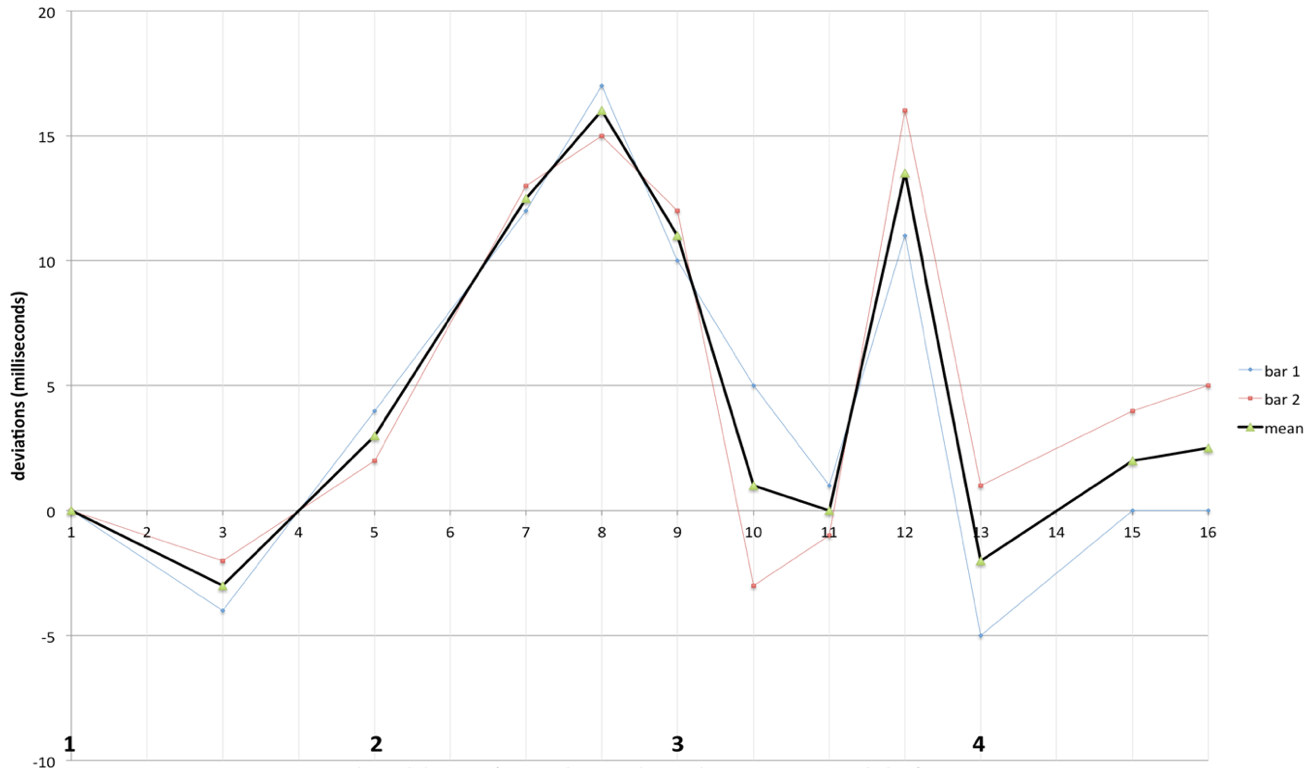
Figure 10: The Winstons, “Amen Brother,” drum break: straight lined scatter graph showing microtiming deviations occurring on the drums in the first two bars. (For TUBS transcription including microtiming deviations, see Table 2.)
Following on from this, perhaps the most profound finding is that the repeating patterns of deviations described above often appear to reflect aspects of the structure and/or arrangement of the pieces from which they are derived, even when these patterns are a feature of a solo drum break.
Vijay Iyer suggested that microtiming deviations might highlight structural aspects of musical material.[82] This theory is supported by Kahl Hellmer and Guy Madison who found that percussionists varied patterns microrhythmically for different song sections.[83] For jazz, Richard Ashley showed that musicians displaced note onsets to highlight motivic structure.[84] Many of the microtiming patterns found in the analyses in this chapter add further weight to these theories and show that drummers vary their performances microrhythmically to enhance arrangements not just from section to section, but even within one and two bar grooves: significant features in arrangements can be highlighted by microtiming deviations. In a qualitative study, Rowan Oliver postulated that drummers appear to respond to, or even jam with, the band in solo drum breaks when the band is not playing.[85] Findings from the song analyses add quantitative weight to Oliver’s study, showing that drummers not only create microtiming patterns that respond to previously heard sections of music, but possibly also predict aspects of musical structures.
This highlights the importance of the drummer in funk grooves: her/his function may not simply be to create a rhythmic structure that the band can use as a musical scaffold or framework; it can be to create rhythmic patterns that are inexorably linked to the musical arrangement. Perhaps this theory can be extrapolated to propose that the drummer (one person) can create the feeling of communal music making by incorporating the musical influence of an entire band into her/his performance. Below are details of the (often novel) findings related to musical structure; these findings are summarised in Table 6.
The One (And Secondary Ones)
Many academics and practitioners have expounded upon the power of the beat one of each bar or riff in funk grooves. This is known as “the One.”[86] A dynamically accented One featuring the simultaneous attacks of many instruments is found in many funk grooves. The songs analysed in this study show that the One can also be expressed microrhythmically: this is evident in at least eight of the above tracks (“Cold Sweat,” “Funky Drummer,” “Sex Machine,” “Super Bad,” “Think (About It),” “Amen Brother,” “Impeach the President,” “Apache”) and is a feature of almost all the James Brown grooves analysed. Microtiming deviations expand from the One and contract back as the One approaches again. If quarter note subdivisions are considered alone, this effect can be observed very clearly in the two bar riff in James Brown’s “Cold Sweat;” see Figure 11. (For table showing microtiming deviations, see Figure 23 in the Appendix).
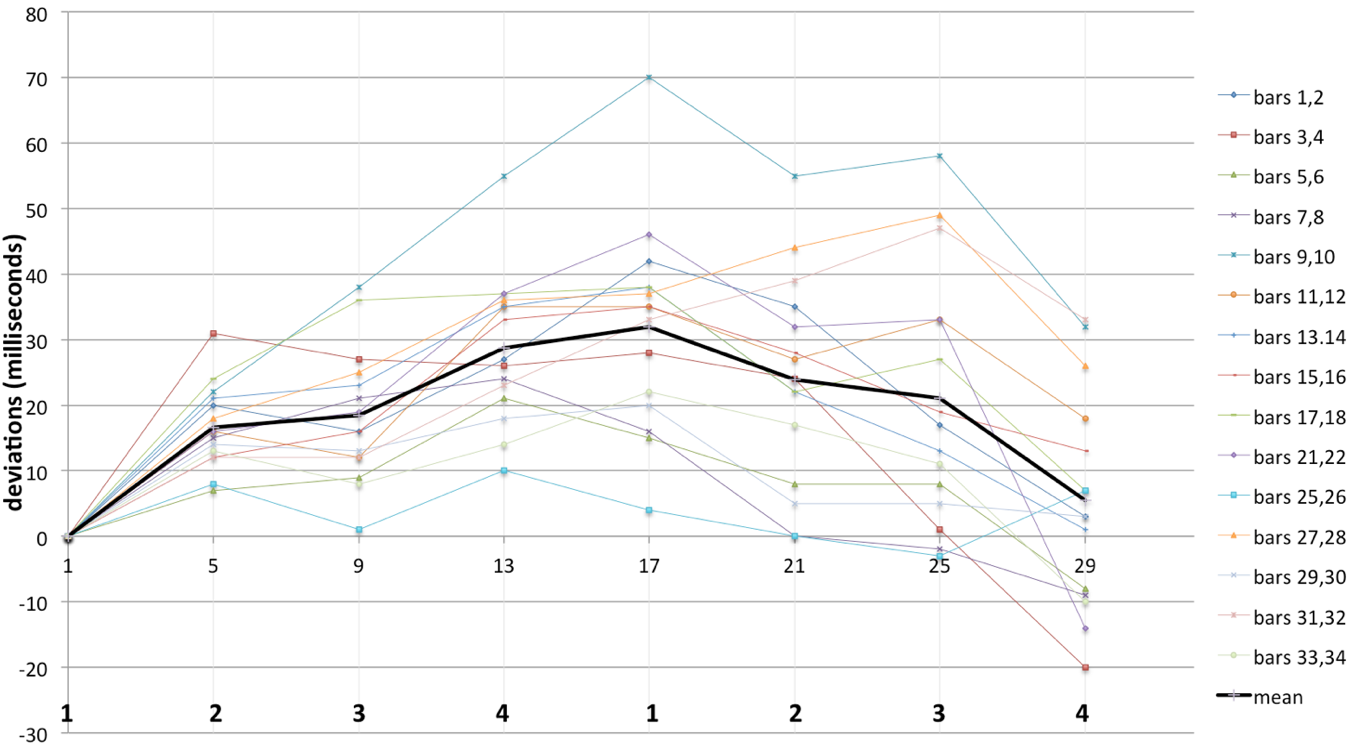
Figure 11: James Brown, “Cold Sweat pts 1 & 2,” straight lined scatter graph showing drum microtiming deviations on quarter notes only. Deviations expand from beat one of the first bar, reach a maximum at the beginning of the second bar, then contract towards the end of the riff. (For table showing microtiming deviations, see Figure 23 in the Appendix.)
When discussing jazz, Ashley noted that musicians might play late notes, then play the following notes relatively early in order to catch up; he described this as a “delay-accelerate strategy.”[87] This is clearly happening in the funk grooves listed above; in places the delay-accelerate strategy is repeated in different iterations of the same groove with frightening accuracy and shows that the rhythmic precision of jazz drummers observed by Honing and De Haas[88] is also demonstrated by funk drummers. Acceleration in order to catch up and land back on the One can be observed most clearly in bars 31 and 32 of the breakdown in James Brown’s “Funky Drummer” (performed by Clyde Stubblefield) where the deviations reduce from 56 ms to 4 ms in a drum fill that takes place during the last seven sixteenth notes of bar 32, apart from just one very minor aberration: the ghost note on the “and” of beat four (see Table 5). Stubblefield creates remarkably similar patterns in the fills at the ends of bars 10 and 28 (see Figure 24 in the Appendix).
Table 5: James Brown, “Cold Sweat pts 1 & 2,” bars 31 and 32 of the breakdown with the deviations of the drum fill on the last seven sixteenth notes highlighted in blue and the One highlighted in red
Timothy Hughes suggested that microrhythmically expressed nodes other than the One might exist in grooves naming them “points of rhythmic unity.”[89] An example of this can be found in Clyde Stubblefield’s drumming in “Cold Sweat.” On the “and” of beat one of the second bar of the riff, almost every two bar chunk has a much shorter deviation than the previous attack leading to a sharp dip in the scatter graph (see Figure 12). The mean deviation at this point is just over 7 ms in contrast to adjacent means that are over 20 ms. The deviations stretch from the beginning of the figure, fall back sharply at this point, then stretch again until the “and” of beat two of the second bar, and finally reduce to land on the One of the following figure. It appears the “and” of beat one of the second bar could be some kind of node, or a “secondary One.” The likelihood of this hypothesis is strengthened if the bass line played by Bernard Odum is examined in detail. Although the bass riff varies slightly on some iterations of the two bar figure (the most frequently occurring pattern is shown in Figure 12), Odum always leans on the low F at the “and” of beat one of the second bar creating a longer and heavier note than all others in the riff. This F
always coincides with a kick drum. When discussing Brown’s 1965 track “I Got You (I Feel Good),” Danielsen points out that the One “is clearly audible in positions other than the first beat of the bar.”[90] It appears that this may also be the case with “Cold Sweat,” a track that was created only two years later. Expanding on his point (above) that “‘staying on the one’ is more suggestive than explicit,” Hughes states “that there has to be clear points of metric unity and […] independent, heavily syncopated rhythms in between those points.”[91] It seems that, for the drums, the “and” of beat one of the second bar is a point of metric unity (or a “secondary One”) and that increased microtiming takes place either side of this point, in addition to the increased deviations either side of the actual One on the first beat of each figure. Discernment of the microtiming deviation of the bass at this point is impossible as it is always articulated after the kick drum hence its attack is obscured. In fact, the majority of bass onsets in the entire 32 bar breakdown are late, so Stubblefield is clearly not being led or perturbed by the timing of the bass line but appears to be establishing a microrhythmic shape for the overall two bar figure.
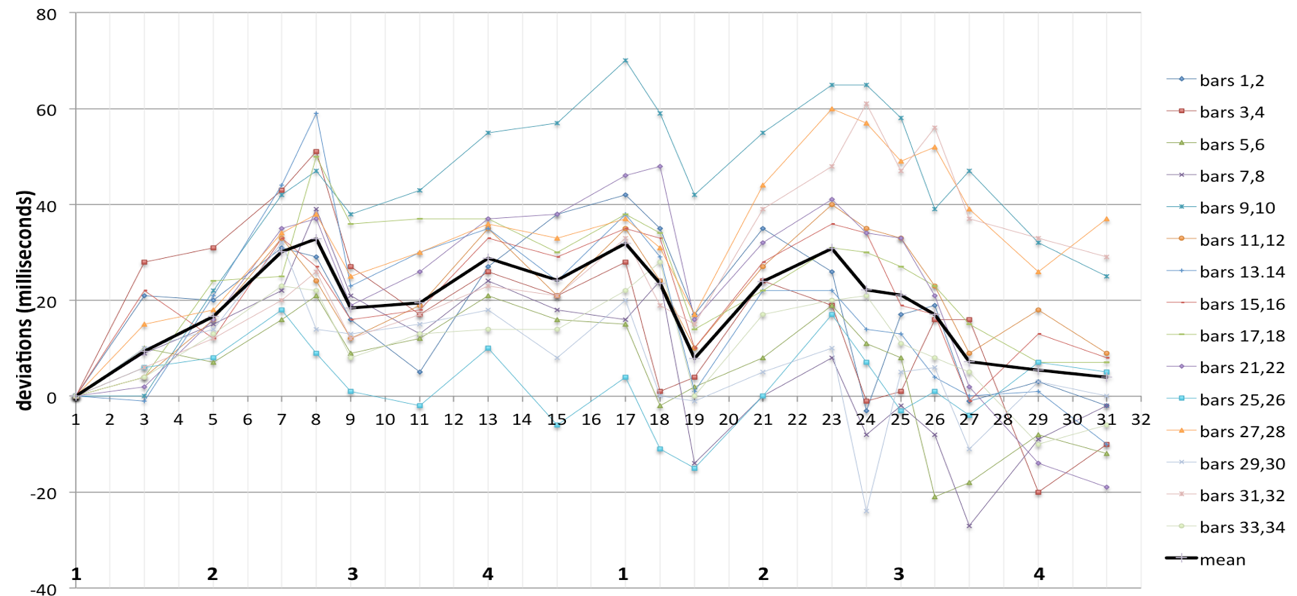
Figure 12: James Brown, “Cold Sweat pts 1 & 2,” straight lined scatter graph showing drum microtiming deviations accompanied by notated bass line. The secondary One is shown dip in the mean line on the “and” of beat one of the second bar (subdivision 19) which coincides with the accented low F on the bass guitar.
In James Brown’s “Super Bad” featuring Clyde Stubblefield on drums (for TUBS transcription including microtiming deviations, see Figure 26 in the Appendix), a similar secondary One can be seen which coincides with a bass run beginning on an F on the “and” of three which takes the groove back to the One (see Figure 13).
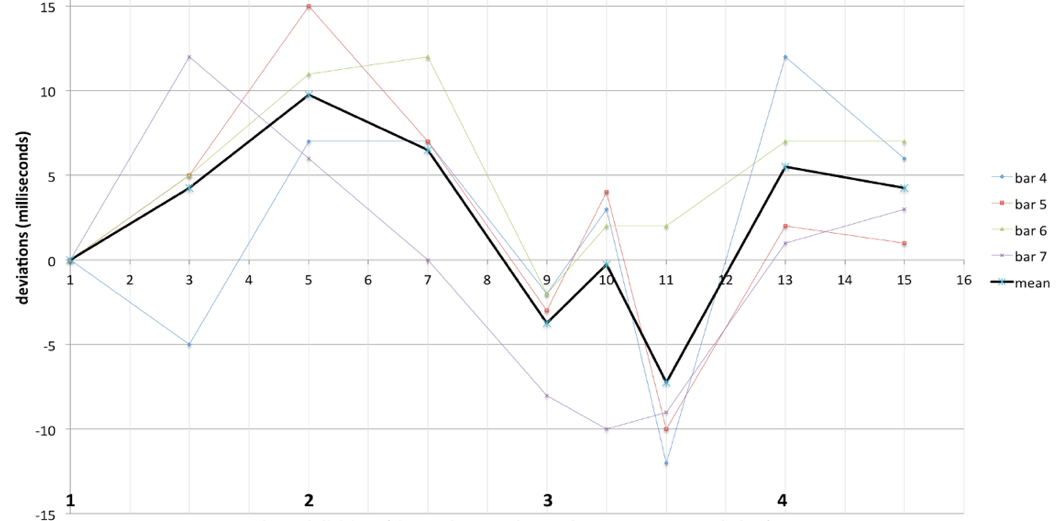
Figure 13: James Brown, “Super Bad,” bars 4–7, straight lined scatter graph showing microtiming deviations occurring on the drums accompanied by notated bass line
Another example of a secondary One can be found in the drum break in “Think (About It)” by Lyn Collins (for TUBS transcription including microtiming deviations, see Figure 27 in the Appendix), which features one of James Brown’s drummers (John Jabo Starks). In addition to its relatively early onset (see Figure 14) the snare on beat four in every bar sounds louder and much more snappy than that on beat two. It appears that Starks is creating a secondary One on beat four. In fact, he is actually shaping the groove timbrally and microrhythmically around the subsequent bars. After the first break, the following bar (bar 24) features a guitar and bass figure starting on beat three, that leads to the root chord (G major) on beat four (see Figure 15). Bar 25 features just drums, tambourine, and a vocal hook “it takes two to make a thing go right,” with the final word “right” landing on beat four (see Figure 15). Bars 26 and 27 repeat this with a new hook “it takes two to make it outta sight” with “sight” landing on beat four. So, following the first break there are four bars with performers aiming for, and creating a strong emphasis on the fourth beat. Beat four becomes a secondary One and Starks predicts this with a relatively early, loud, and snappy snare on beat four of the first break and repeats this in all subsequent breaks (see Figure 14).
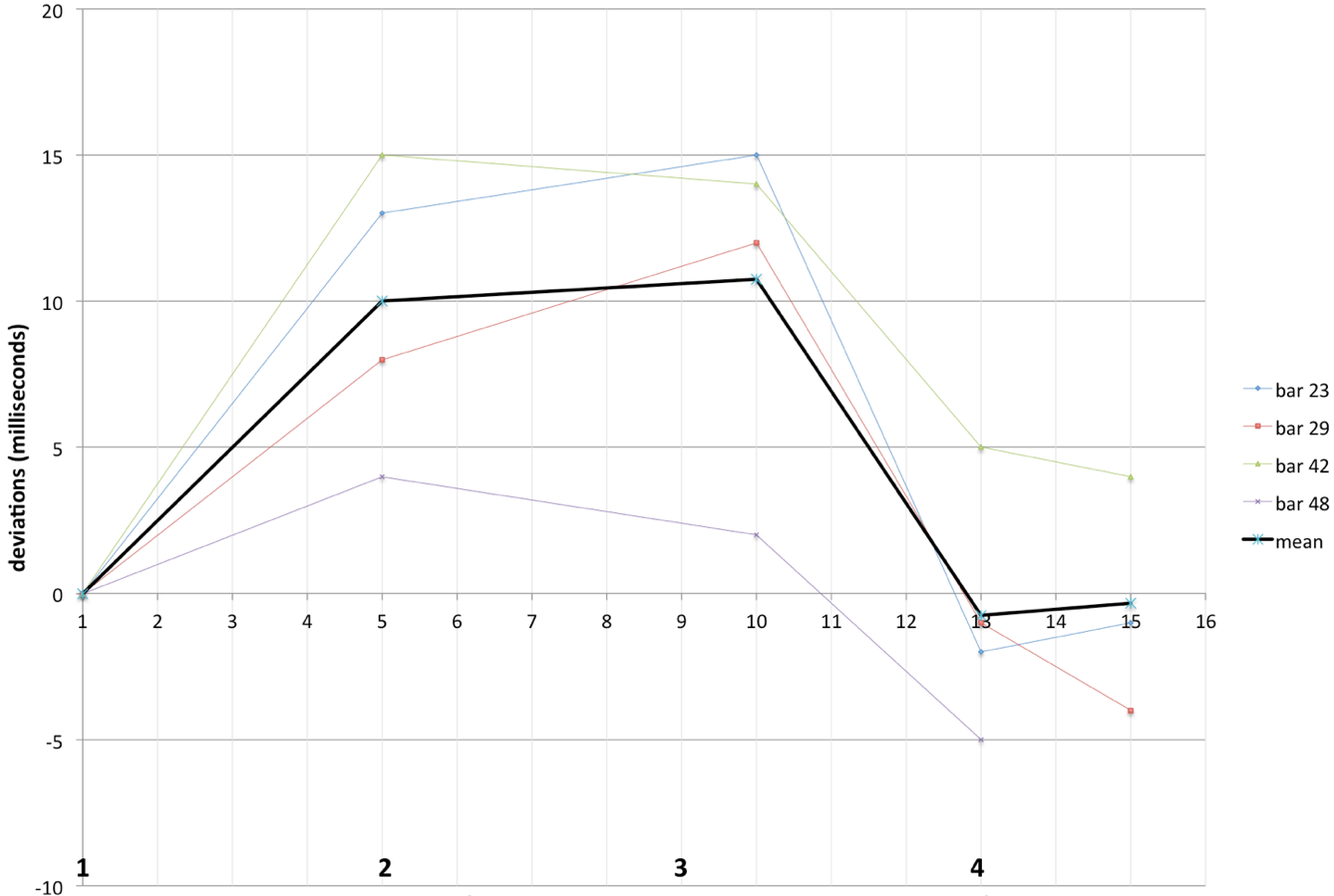
Figure 14: Lyn Collins, “Think (About It),” drum breaks, straight lined scatter graph showing microtiming deviations occurring on the drums
Figure 15: Lyn Collins, “Think (About It),” transcription of bars 24 and 25 (bass and guitar are octave transposed)
The instrumental funk track “Amen Brother” by The Winstons contains a four bar drum break performed by Gregory Coleman. This break has been transcribed in detail by Rowan Oliver (see Table 2 for TUBS transcription with accompanying microtiming deviations). The first two bars are almost identical; then Coleman varies the pattern in the third and fourth bars.
Figure 8 shows the deviations presented as a straight lined scatter graph. Despite the considerable variation in the second half of the break, including some beat displacement, all four iterations have a reasonably similar contour. However, as highlighted above, the ability of Coleman to repeat microtiming patterns accurately becomes strikingly conspicuous if the first two, almost identical bars, are considered in isolation (see Figure 10). When investigating links between the drum groove and the arrangement, it makes sense to focus on the first two bars as these are similar to the drum pattern in the main instrumental groove.
As with “Think (About It),” beat four is performed relatively early. If the groove preceding the break is considered, there is an explanation for this. The horn figures, which contain frequent sustained notes and begin or end on the One, are underpinned by a strong, regular rhythmic pattern on the organ (see Figure 16).
Figure 16: The Winstons, “Amen Brother,” transcription of the repeating organ figure in bars preceding the break
Apart from the horns and the drums, the organ is the most prominent instrument in the mix. The rhythmic pattern created by Coleman in the first two bars of the break clearly mirrors the rhythm and dynamics of the organ part. Like the bass/guitar combination and the vocal hook in “Think (About It),” the organ figure ends on beat four with an accented chord that creates a secondary One (see Figure 17 for a transcription of the first bar of the break – the second bar is identical).
Figure 17: The Winstons, “Amen Brother,” transcription of the drums in the first bar of the break
The patterning of the first bar of the drum break based on the organ rhythm in the preceding bars becomes more obvious if the rhythm of the organ is compared with the rhythm created in the break by the kick drum, snare hits and ghost notes on the snare (see Figure 18). To emphasise the secondary One, Coleman accents the snare on beat four (subdivision 13) and performs it relatively early. The analysis of the “Amen” break shows that the micro-rhythmic shape of the first two bars is based on aspects of the arrangement, mainly the organ part.
Figure 18: The Winstons, “Amen Brother,” comparison of the rhythm of the organ prior to the break and the rhythm created in the break by kick drum, snare hits and snare ghosts
“Impeach The President” by the Honey Drippers begins with two bars of solo drums before a compere introduces the band. There are a total of five bars before the band enters. As with “Amen Brother,” the straight line scatter graph derived from the microtiming deviations (see Figure 19) demonstrates the ability of drummers to repeat patterns of deviations within just a few milliseconds of each other.
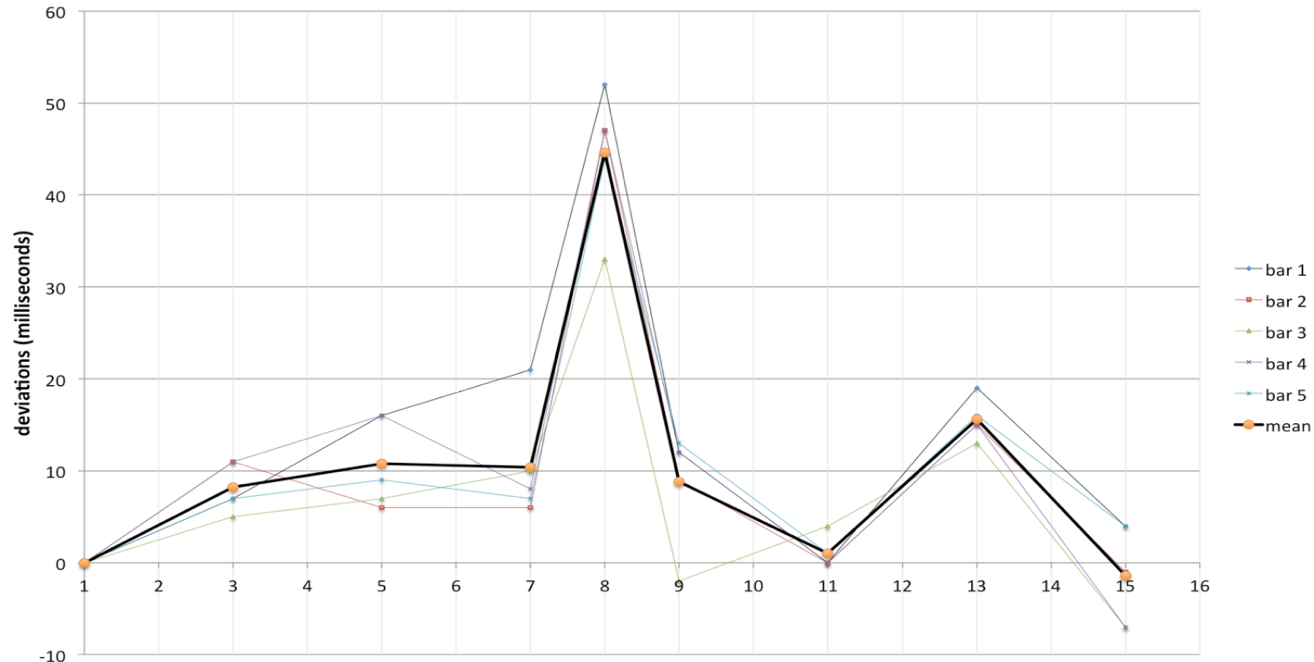
Figure 19: The Honey Drippers, “Impeach The President,” drum break, straight lined scatter graph showing microtiming deviations (For TUBS transcription including microtiming deviations, see Figure 30 in the Appendix.)
If the deviations on eighth notes only are considered (in order to remove the large spike on the last sixteenth of beat two created by a single swung sixteenth note), the underlying microtiming patterns can be observed more clearly (see Figure 20).
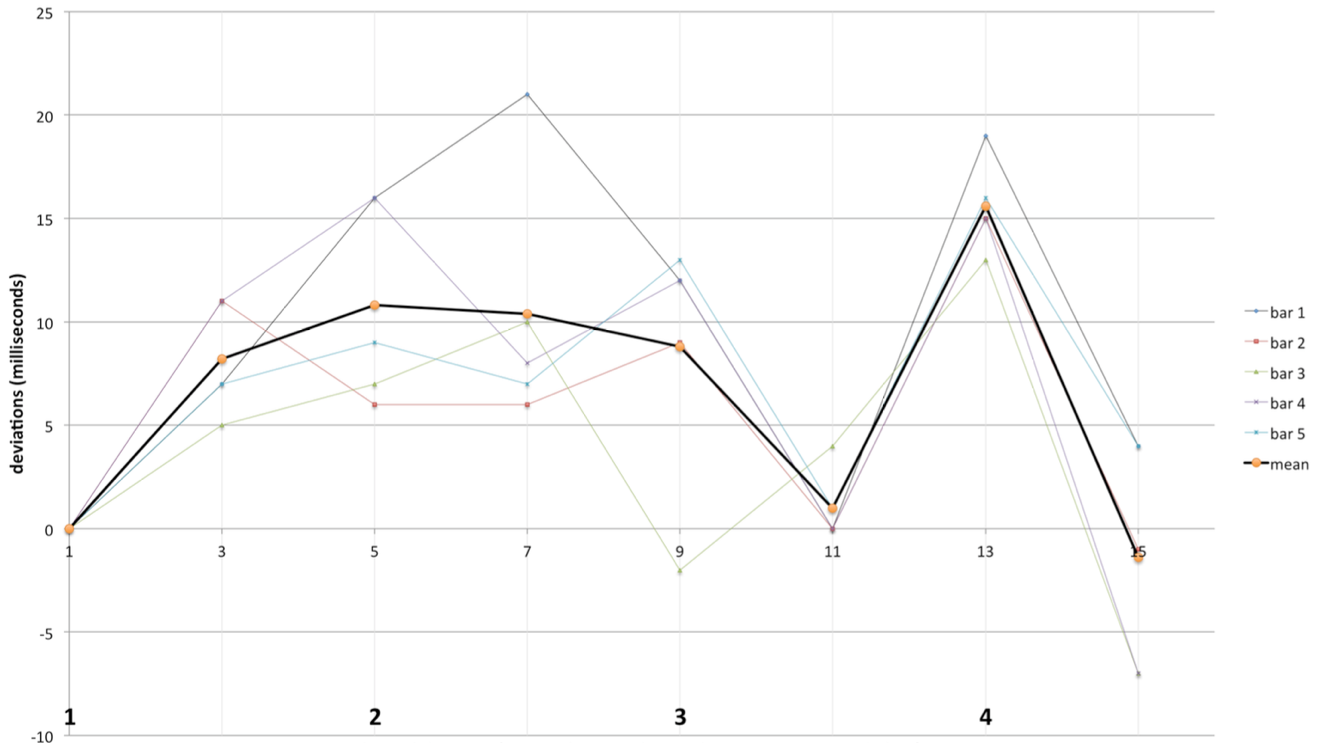
Figure 20: The Honey Drippers, “Impeach The President,” drum break, straight lined scatter graph showing microtiming deviations occurring on the drums on eighth notes only
In addition to the microrhythmic pull of the One, as with many of pieces, there is a reduction in deviations at some point between the beginning and end of each bar: here it is on the “and” of beat three (subdivision 11 on Figure 20).
Once the guitar and bass enter in bar six, the rationale for the timing and articulation of the drum part during the break becomes apparent (see Figure 21). The bass guitar enters with a firmly articulated root note (E) on beat one, creating a powerful One with the kick and hi-hat. Following this, microtiming deviations on the drums expand. A sixteenth note run on bass takes the listener to the subdivision on the last sixteenth of beat two; this is highlighted by the kick, hi-hat and accented bass and is also swung. The bass then drops out for the rest of the bar leaving space for a heavily accented guitar chord which is articulated on the “and” of three coinciding with the relatively short deviation on the heavily accented open hi-hat and kick creating a secondary One. This guitar chord is sustained with the open hat drawing the listener to the delayed backbeat on four. The sustained chord on the guitar is finally closed with a snappy scrape on the “and” of four accompanied by a relatively early kick and hi-hat, which takes the listener back to the One at the beginning of the next bar. The musical shape of the drum, bass and guitar groove is established timbrally, dynamically, rhythmically, and micro-rhythmically by the drums alone, before the bass and guitar enter. This further strengthens the argument that patterns of microtiming deviations frequently relate to aspects of the piece from which they are derived rather than existing as stand-alone microrhythmic patterns.
Figure 21: The Honey Drippers, “Impeach The President,” transcription of bar 6 (bass and guitar are octave transposed)
In total, six of the fourteen tracks analysed contain secondary Ones as follows:
“Funky Drummer”
“Cold Sweat”
“Super Bad”
“Think (About It)”
“Amen Brother”
“Impeach the President”
These secondary Ones are timed relatively early in relation to other attacks at a microrhythmic level. The analyses in this chapter show that secondary Ones are often used to highlight certain aspects of arrangements. For example, in “Cold Sweat” and “Super Bad,” the secondary Ones are influenced by the shape of the bass riff, in “Think (About It),” the stimuli are an instrumental riff and a vocal hook, the “Amen Brother” secondary One appears to be based on the prominent organ part and in “Impeach the President,” the guitar is the influencing factor. These secondary Ones often continue to occur in drum breaks once the rest of the band has stopped playing, or even before the band has entered, demonstrating that the drummer is grooving with the band, even when the band is not playing. This novel finding demonstrates the ability of drummers to shape their performances in an extremely subtle rhythmic manner to align with the arrangements and grooves of funk songs.
The “And” of Beat Three
For funk grooves, the “and” of beat three is described by Rowan Oliver as a “significant point in the bar,”[92] so some kind of microtimed highlight of this point might be expected. In eleven of the tracks analysed, the “and” of three is emphasised by a composite hi-hat and kick attack. In eight of these eleven tracks, this composite attack is also microtimed relatively early. So, it appears that this significant point, highlighted by Oliver, is often accented, and emphasised both timbrally and rhythmically. In some tracks this feature calls attention to a significant aspect of another instrumental part, such as the bass line in “Super Bad;” in others, such as “Sex Machine,” it simply enhances the rhythmic shape of the arrangement. Based on the tracks studied here, and the theories provided by Oliver, there is some evidence that the importance of this point is codified into the rhythm of many funk grooves.
Beat Four
As shown in Table 6, beat four is positioned relatively early in eight of the tracks analysed, and for three of these tracks it is the position of the secondary One. This novel finding was an unexpected discovery and was not predicted; it actually conflicts with expectations. It adds weight to the finding regarding backbeats: they are not a universal feature of these tracks, and it is possible that timing due to the arrangements/musical structures is prioritised over the backbeat at this position in the bar.
Table 6: Summary of findings focusing on structural aspects of the songs analysed (Bold lines group tracks with the same drummer together.)
The above findings associated with structure and/or arrangements were not anticipated, and the implications are significant for all developers of software and hardware music sequencing systems. Clyde Stubblefield’s microrhythmic grooviness in “Funky Drummer” might contain less musical meaning if transferred out of context to another piece of music, yet it is possible to buy digital templates that recreate his deviations. Commercially available digital groove templates, a feature of many drum machines, sequencers and digital audio workstations, may be less effective than previously thought unless arrangements are built around their microrhythmic shapes.
Conclusions
Systematic microtiming is clearly evident in every song analysed bar one. Varying degrees of swing from imperceptible to clearly discernible were found to be an almost universal feature. Based on the fourteen tracks analysed, back beat delay appears to be the musicians’ choice rather than a codified element of funk. Many of the tracks contained patterns of deviations related to their arrangements, possibly enhancing the experiences of listeners (although this cannot be assumed from the observations in this study). In addition to this, the one track that did not contain systematic deviations, “In Time” by Sly and the Family Stone, is still an incredibly effective funk groove which created a significant impression on Miles Davis.[93] So, although the evidence suggests that microtiming patterns are carefully sculpted by musicians and are often based on aspects of arrangements, they are not imperative in the creation of funk grooves.
Methodological Limitations
As already explained, a human element was involved in the selection of materials, and choice of songs to be analysed was sometimes dictated by the existence of discernible onsets. In addition to this, there were unavoidable weaknesses in the analyses. Calculation of deviations was reliant on a certain amount of human choice. Due to the emphasis on the importance of the One in the literature, for every track, the first beat of each iteration of each groove (or riff) was taken as zero milliseconds or the start point for the superimposition of the isochronous grid. Depending on the intentions of the composer or performers, this may, or may not have been an appropriate starting point for the grid (see the above section on the determination of the grid). As drum onsets were less likely to be obscured and tended to have greater microtiming deviations, these were often the focus rather than hi-hats or other cymbals. Onsets were often obscured by other instruments limiting the number of identifiable microtiming deviations. Many of the tracks contained tempo fluctuations, some were significant. To mitigate for this, individual, or pairs of bars were analysed separately; however, it is still possible that deviation measurements could have been affected by tempo changes occurring within each bar. To complicate things further, there may be issues surrounding the use of superimposed isochronous grids as reference points from which to calculate microtiming deviations; these are discussed in greater depth below. To summarise, although the attention to detail was painstaking, there was still the potential for inaccuracies and inconsistencies due to the processes involved.
Finally, although over 1000 data points were generated, only fourteen songs were analysed and some of the findings and deductions were based on a limited number of groove iterations and hence, limited data, meaning that a certain amount of speculation was involved in the interpretation of potential reasons for patterns of microtiming deviations. Although the field is expanding, more analyses are certainly indicated for future developments.
Future Directions: A Flexible Grid?
The metronome, traditional staff notation, drum machines, sequencers and digital audio workstations all provide musicians and composers with isochronous grids as references around which to arrange musical events. Much of this paper is based on the assumption that the isochronous grid is the norm: all the songs analysed except “In Time” by Sly and the Family Stone, which was recorded using a drum machine to provide rhythmic foundation, were recorded without reference to a metronomic grid (with no click track), yet I have chosen to employ superimposed isochronous grids as references from which to calculate microtiming deviations. The grid provides a valuable starting point for analysing microrhythmic feel, but as Danielsen points out: “There is no guarantee that that a metric grid in a form that would measure rhythmic events – that is, an isochronometric grid of points in time – is actually at work when we listen to music.”[94]
Unsurprisingly, although rhythmic asynchronies are present, findings do show that “In Time” does conform quite closely to the metronomic grid provided by the drum machine. In addition to this, some of the tracks analysed do appear to be loosely built around isochronous grids. Both “Cissy Strut” and “Funky President” feature fairly regular sixteenth note swing based around a reasonably stable metronomic framework.
However, many of the songs analysed feature microrhythmically highlighted musical nodes (Ones and secondary Ones) around which microtiming deviations expand and contract relative to the isochronous grid. Perhaps, aligning the grids to these patterns of fluctuations makes more musical sense when analysing grooves than relating everything to superimposed isochronous grids? These non-isochronous timing grids might create a superior representation of how the beat is actually experienced by performers and listeners. Danielsen supports the proposition of non-isochronous grids as follows:
The micro-rhythmic features of the groove seem to be particularly important. Sometimes the close analysis of such subtle micro-rhythmic designs eludes traditional notation-based representations of rhythmic structure. Moreover, micro-rhythmic features have a structural impact as well. If we overlook this, we risk losing both crucial aspects of a groove’s structural identity and the critical interaction between this virtual structure and the actual sounds.[95]
If Danielsen’s “beat bin” model (see Figure 36 in the Appendix) is applied, meaning the widths of beats created by multiple closely timed onsets (as evidenced in this study, see the above section on “Note onset determination”) are also considered, these non-isochronous grids should also include beat durations for each subdivision. Figure 22 is a graphic representation of the grid based on the drum break from “Funky Drummer” by James Brown. The inter-onset intervals and beat bin widths are derived from all eight iterations of the groove. Perhaps this flexible view of the grid is more appropriate for future research into microtiming and microrhythm?
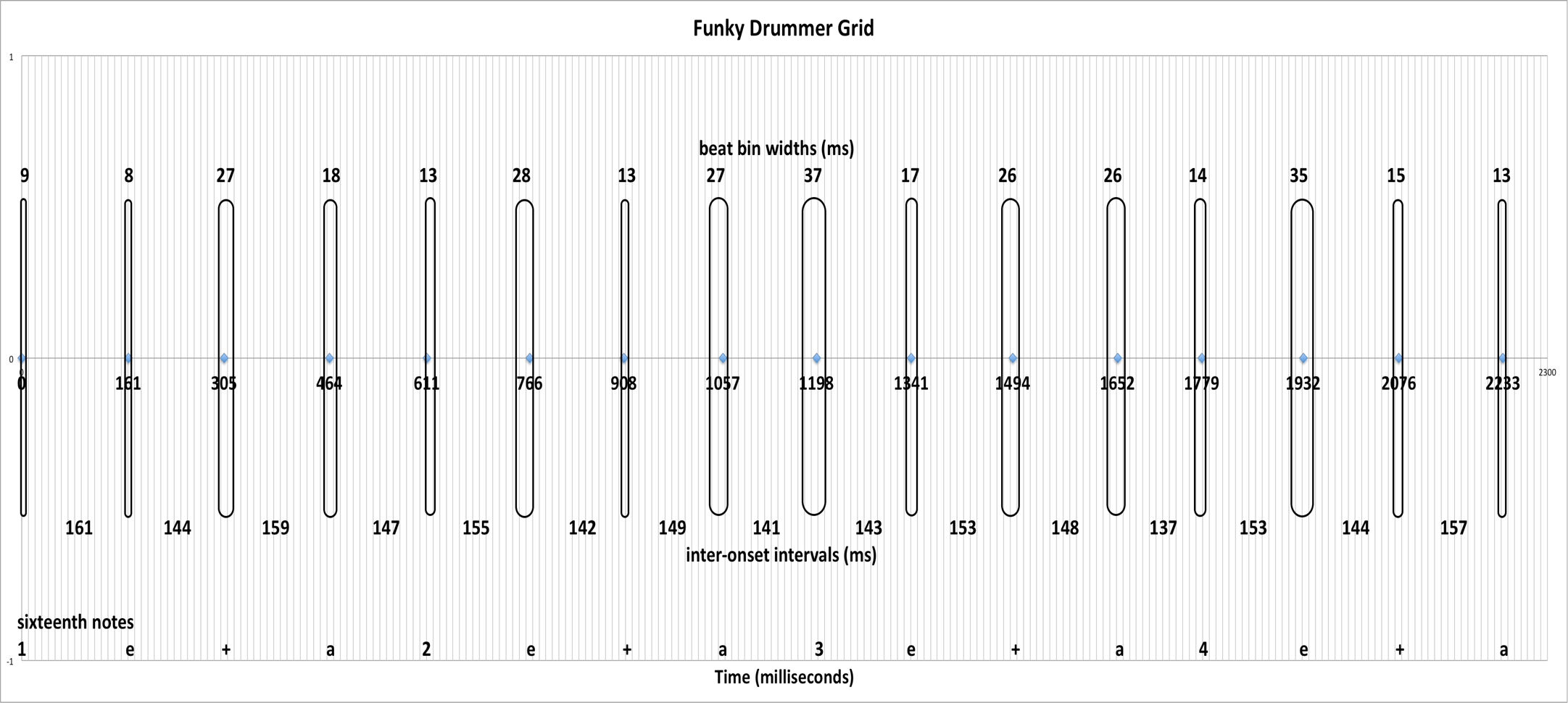
Figure 22: Graphic representation of the grid for the drum break from “Funky Drummer.” The blue diamonds show the positions of the mean sixteenth note subdivisions.
Appendix
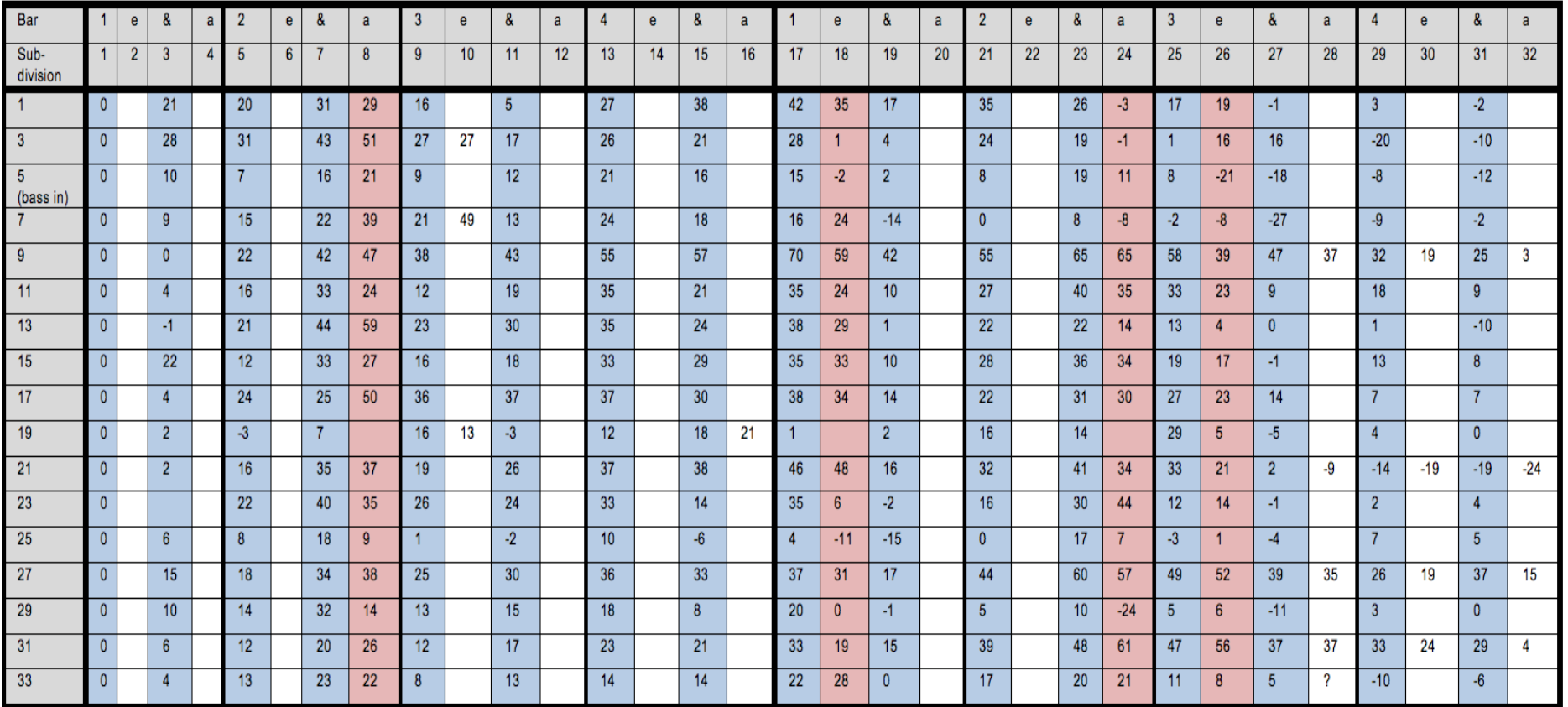
Figure 23: James Brown, “Cold Sweat”: sixteenth note microtiming deviations (condensed from transcription); negative = early, positive = late
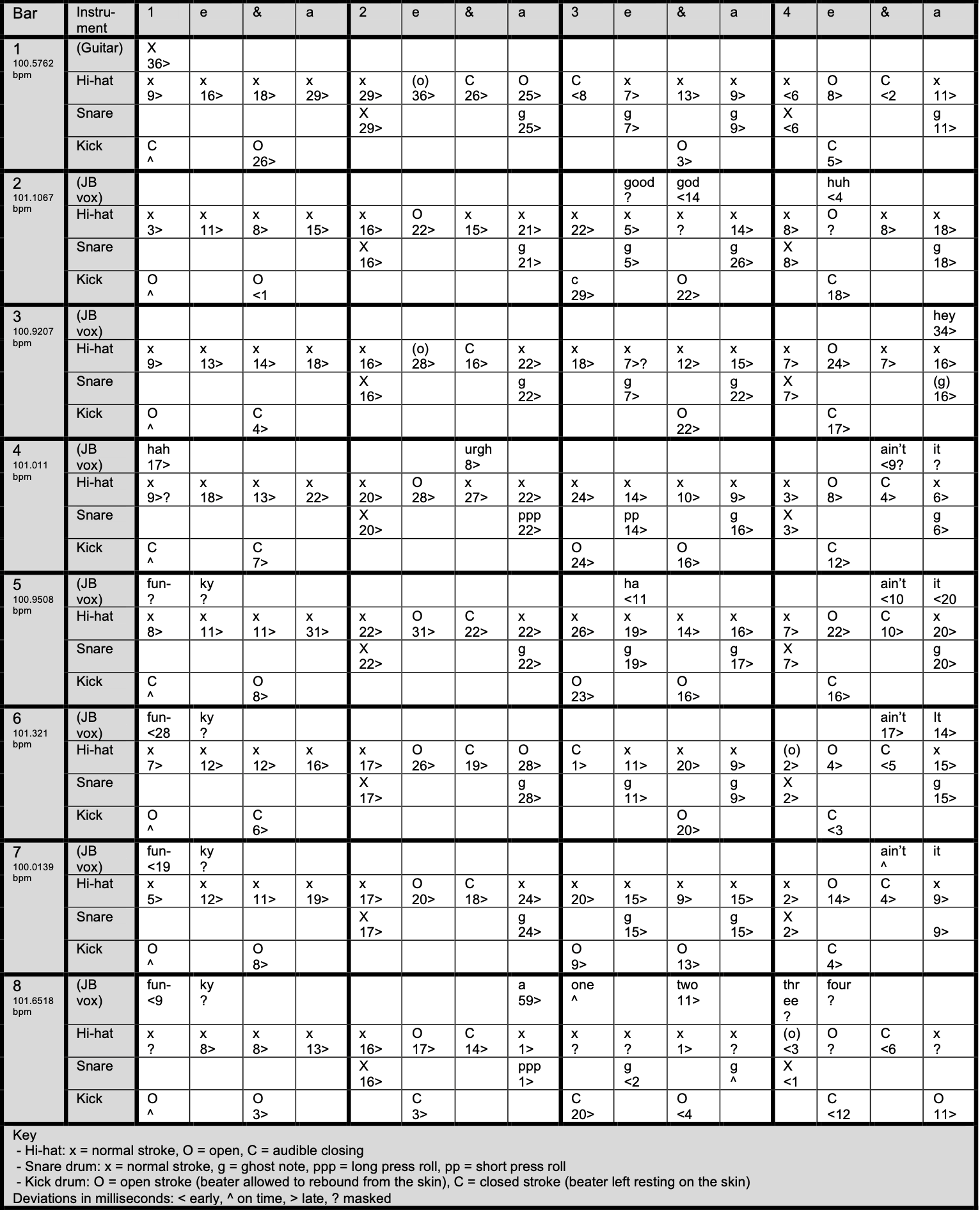
Figure 24: James Brown, “Funky Drummer pts 1 & 2,” drum break: Rowan Oliver’s transcription[96] with microtiming deviations added
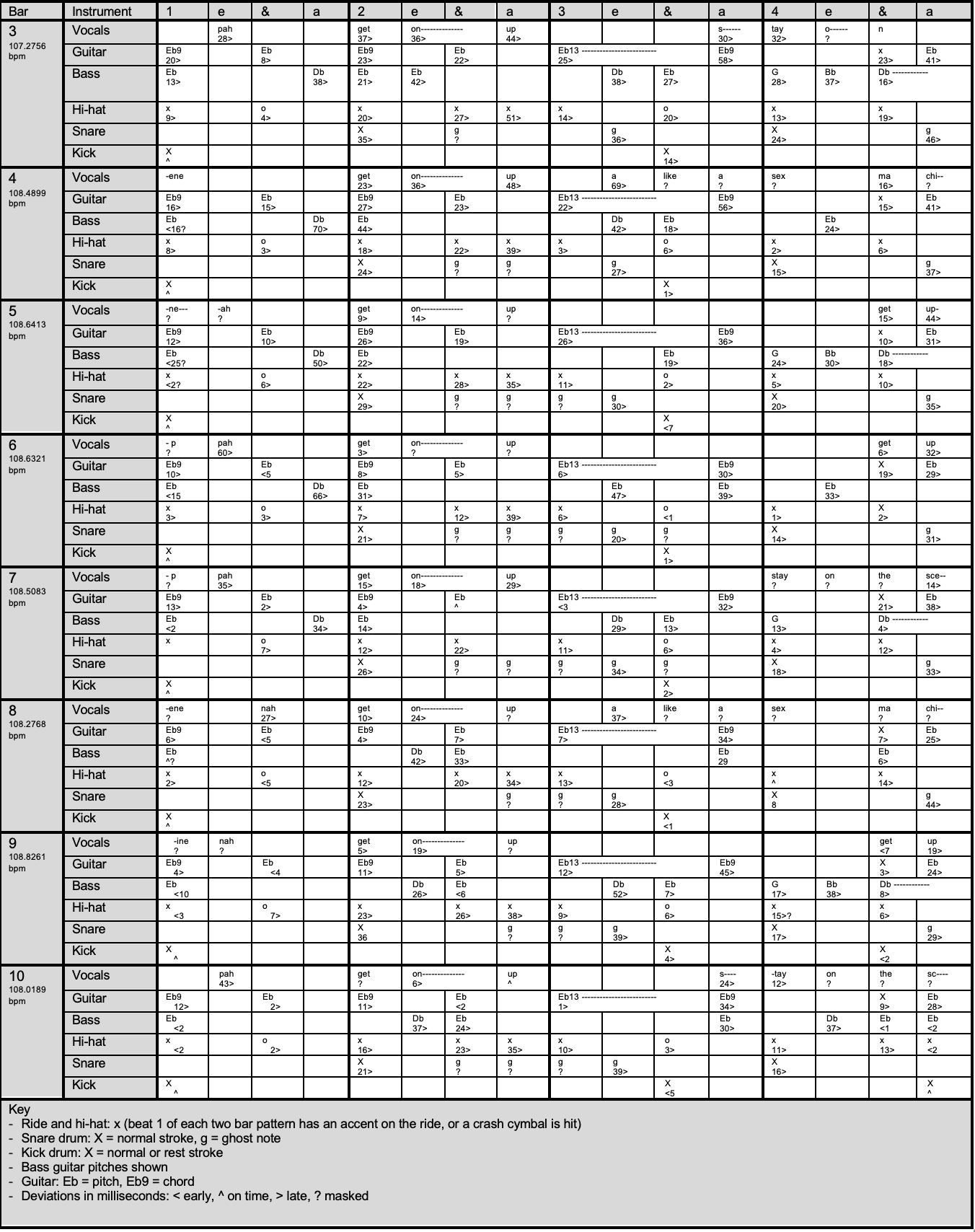
Figure 25: James Brown, “Sex Machine”: transcription of bars 3–10
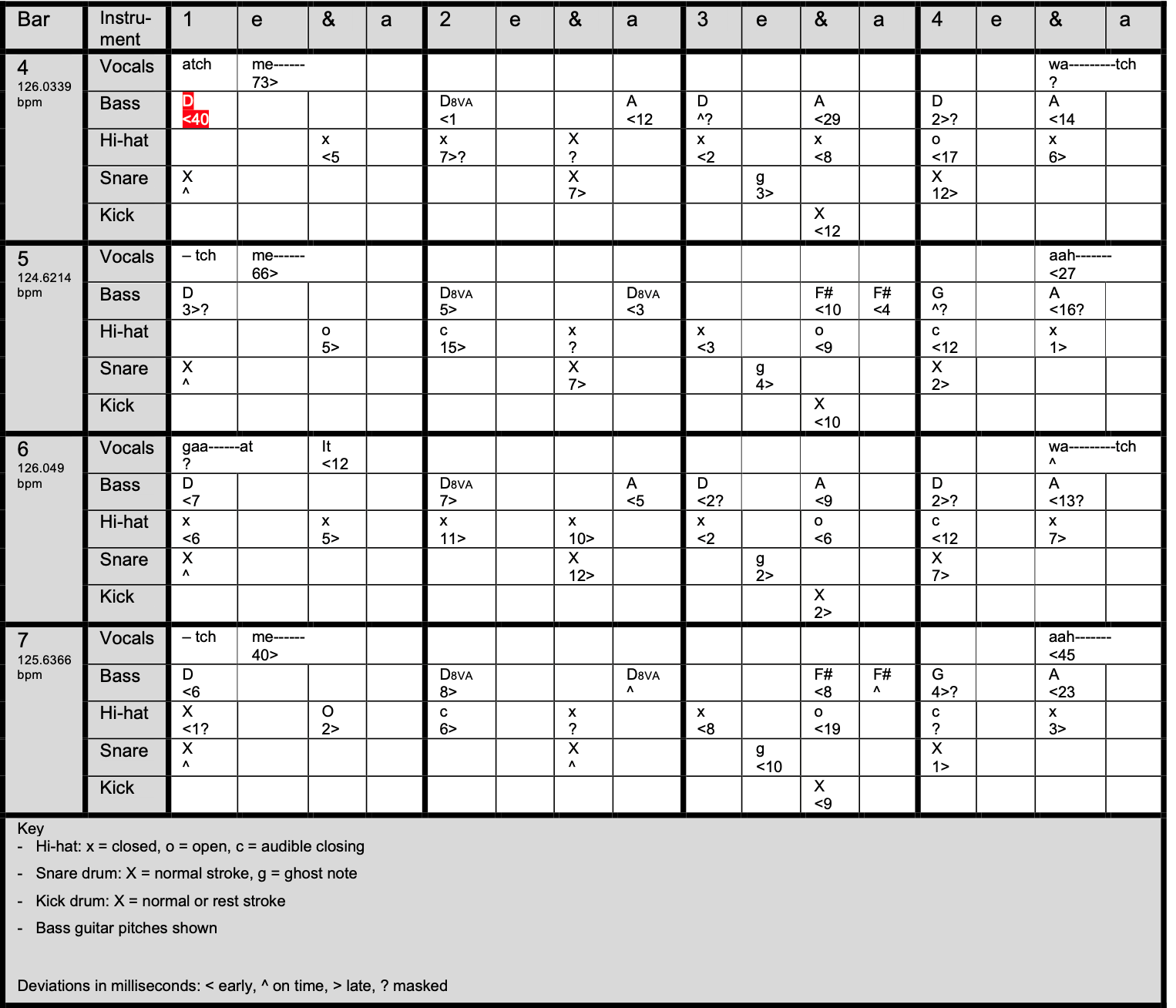
Figure 26: James Brown, “Super Bad”: transcription of bars 4–7
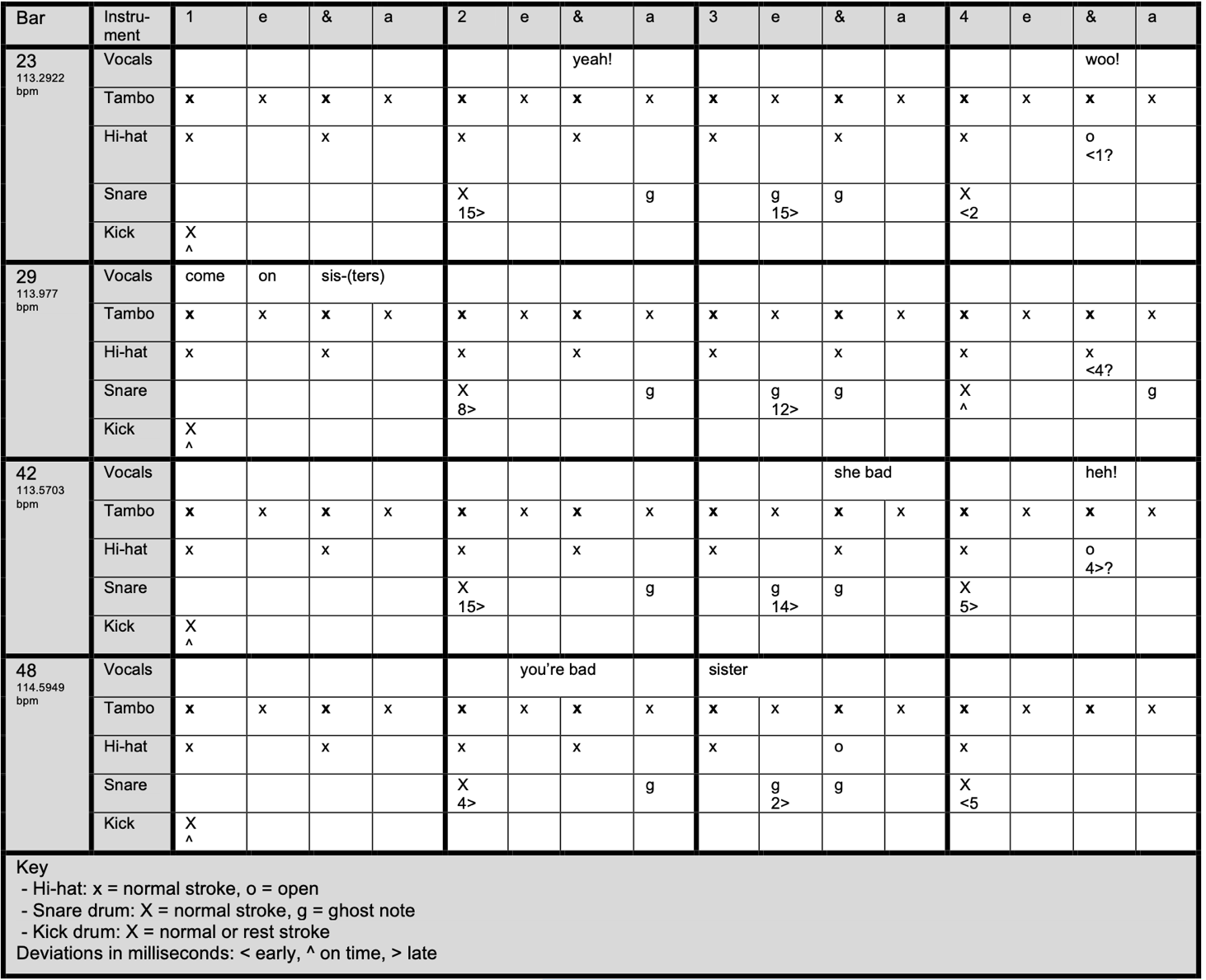
Figure 27: Lyn Collins, “Think (About It),” drum breaks: Rowan Oliver’s transcription[97] with microtiming deviations added
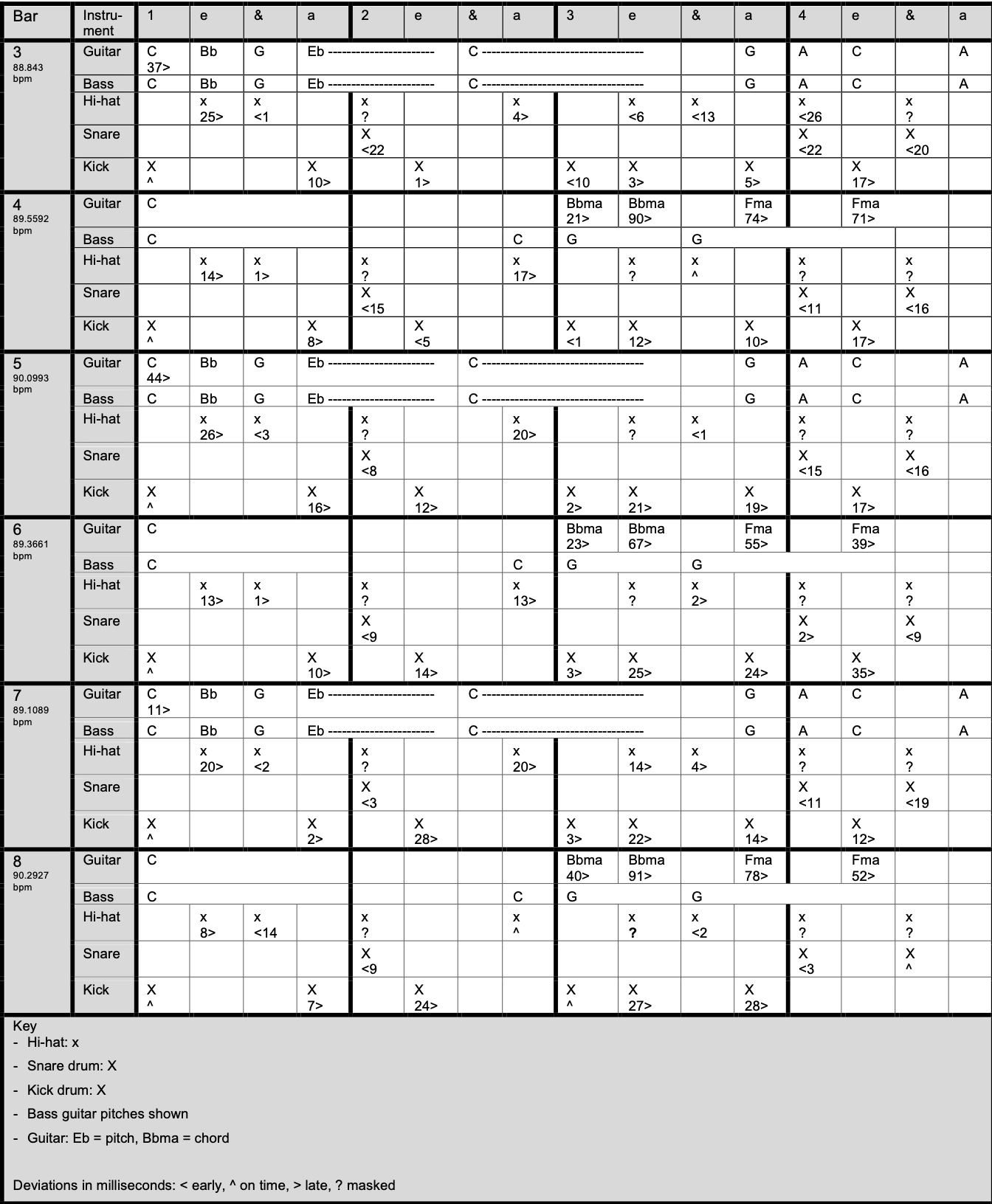
Figure 28: The Meters, “Cissy Strut”: transcription of bars 3–8
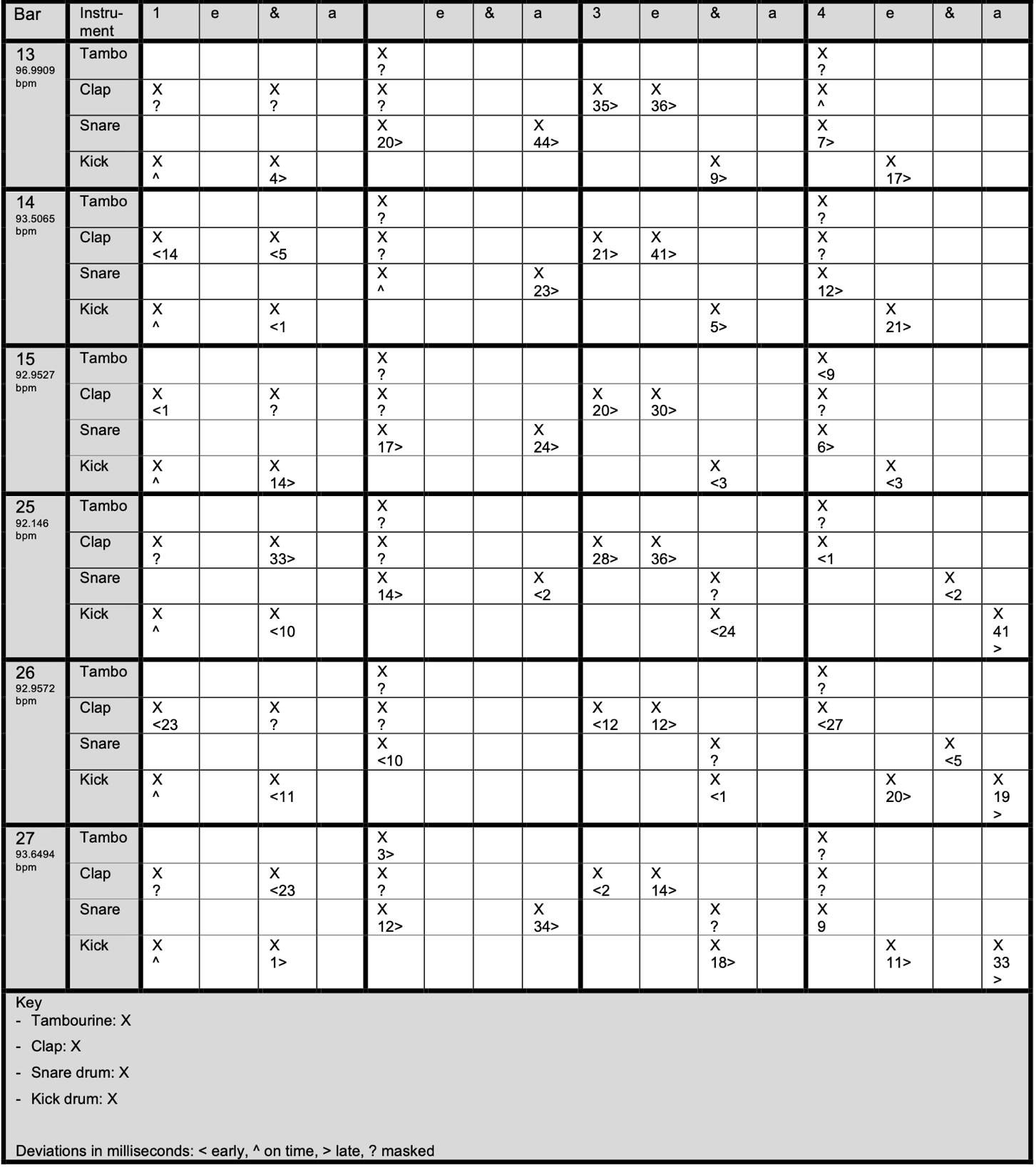
Figure 29: The Meters, “Handclapping Song”: transcription of bars 14, 15, 26 and 27
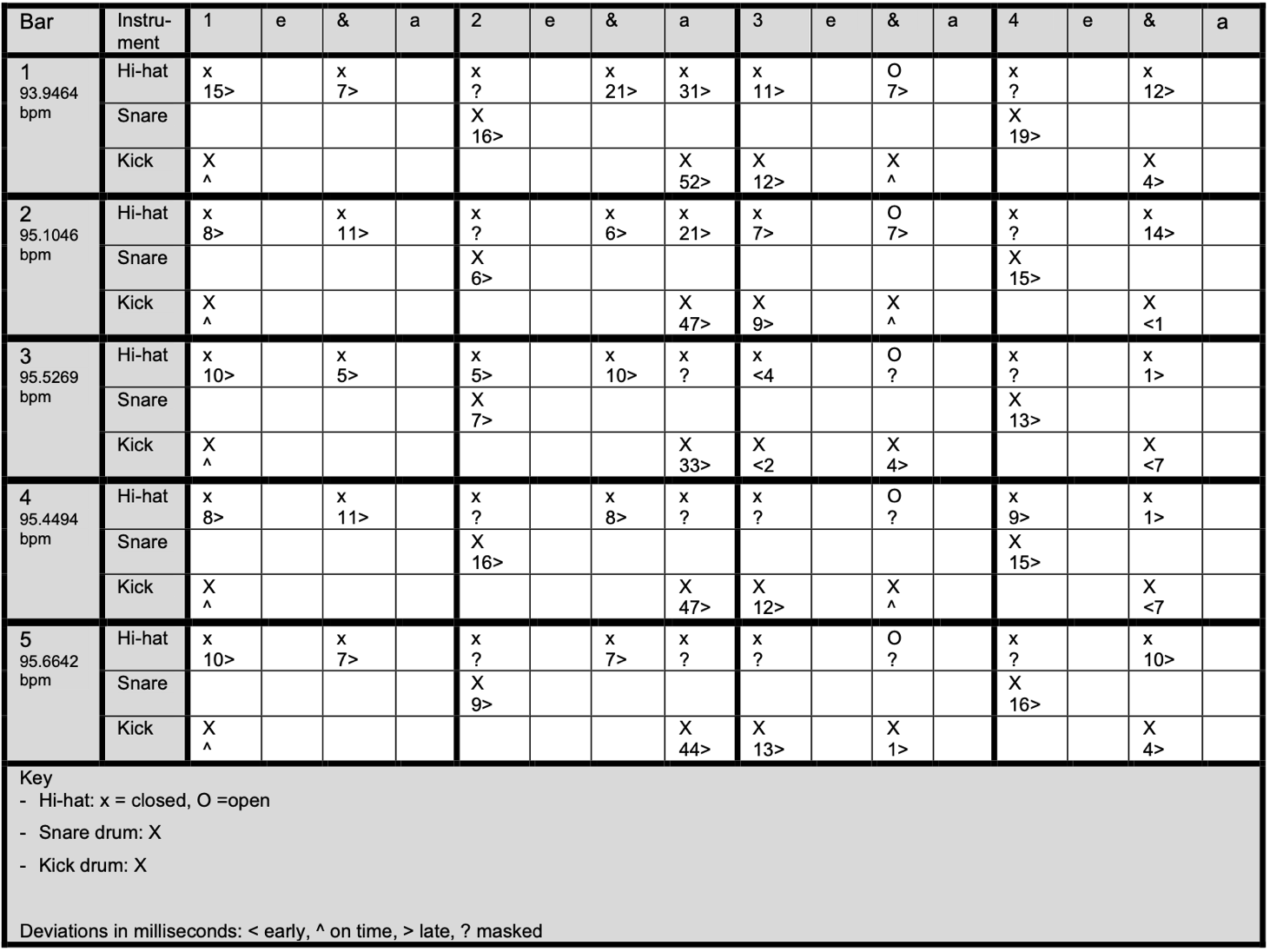
Figure 30: “Impeach The President” by The Honey Drippers drum break: Rowan Oliver’s transcription[98] with microtiming deviations added
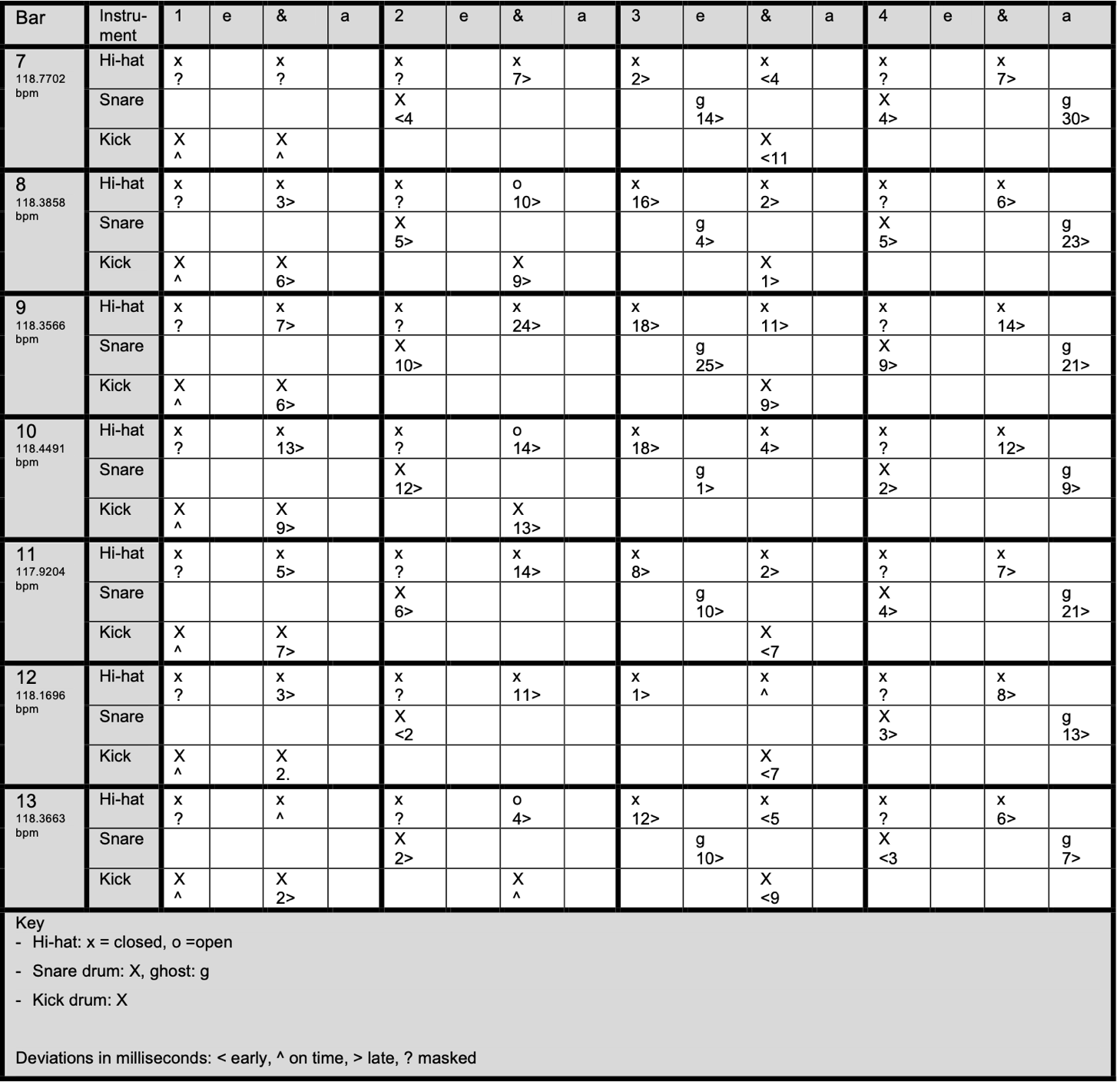
Figure 31: The Incredible Bongo Band, “Apache”: transcription of bars 7–13 of the drum break
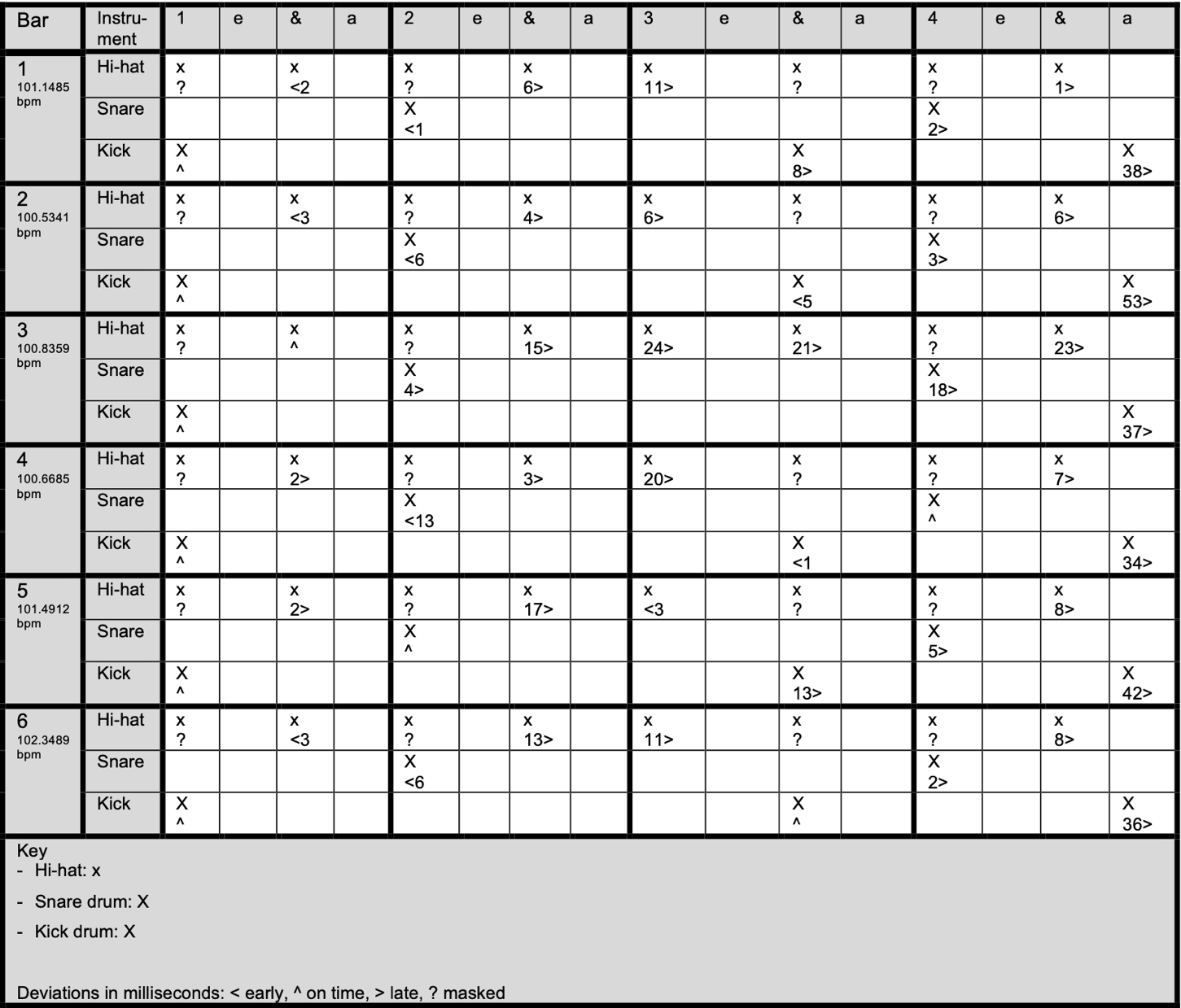
Figure 32: Sly and the Family Stone, “Sing a Simple Song”: transcription of bars 1–6 of the break
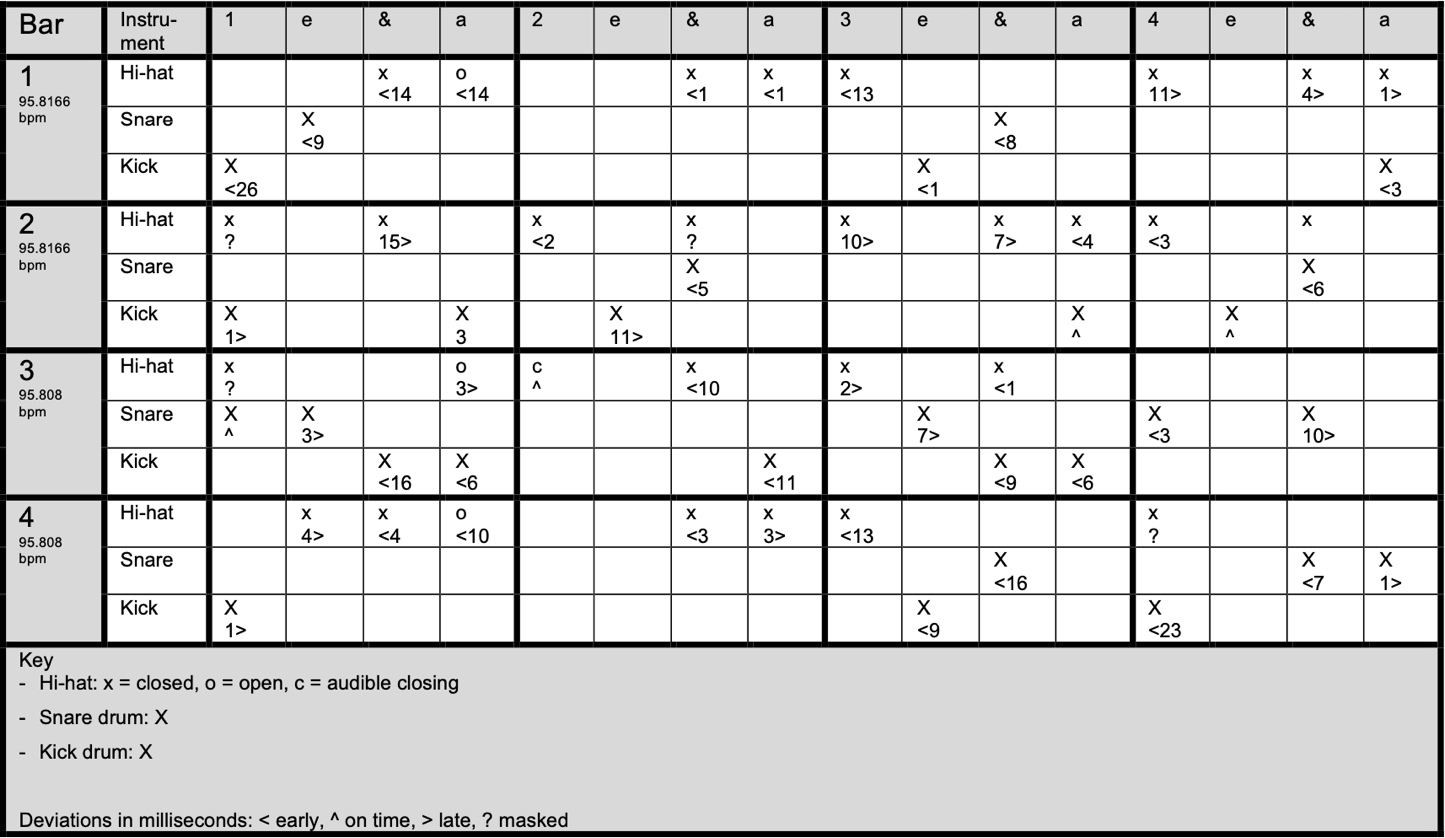
Figure 33: Sly and the Family Stone, “In Time”: transcription of the drum break
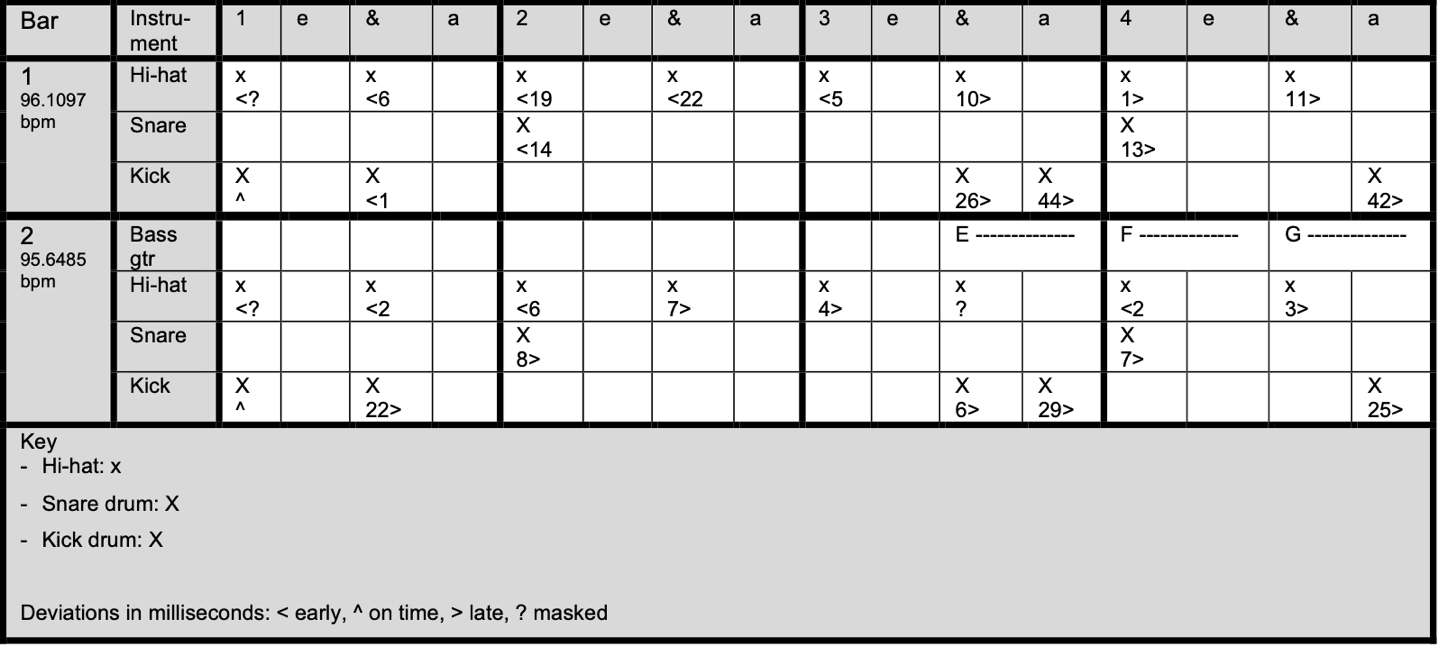
Figure 34: The Skull Snaps, “It’s a New Day”: transcription of the drum break
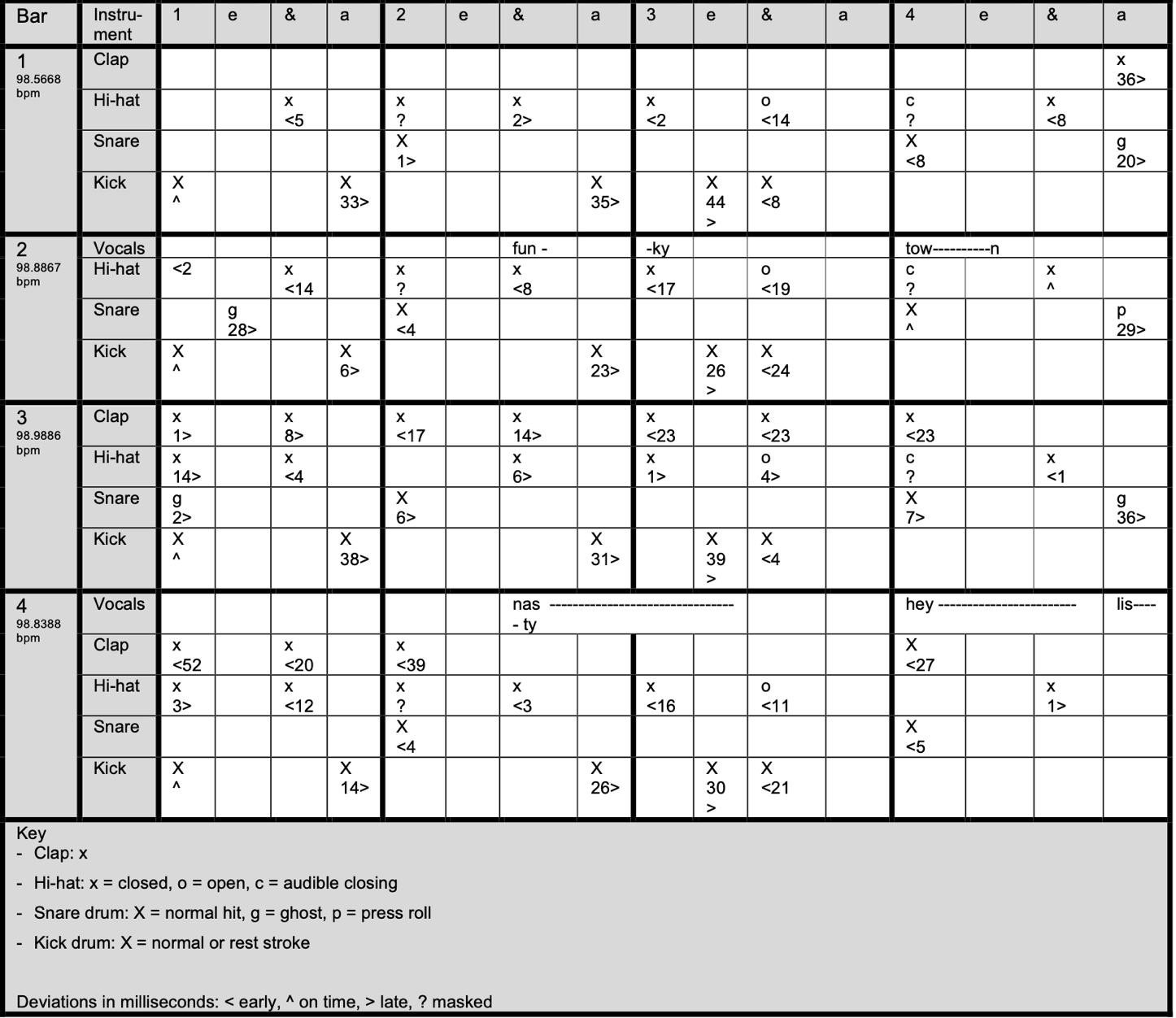
Figure 35: James Brown, “Funky President”: transcription of the drum break
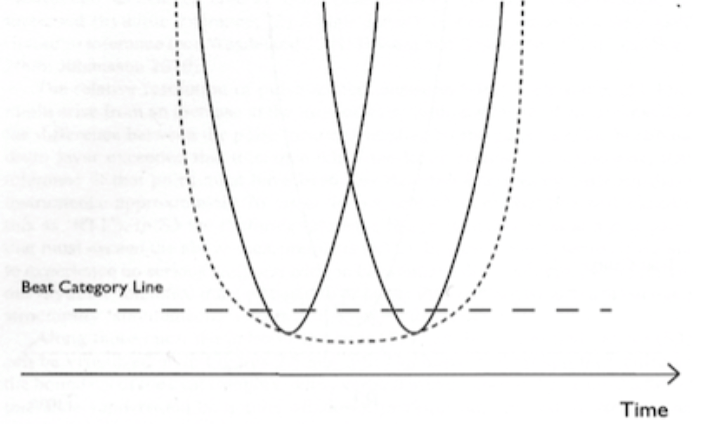
Figure 36: Danielsen’s (2010, 32) beat bin model.[99] In the graphic representation, two attacks are contained within one wide beat.
Notes
See Iyer 1998; Freeman/Lacey 2002; Hughes 2003; McGuiness 2005; Danielsen 2006; Oliver 2015; Câmara 2016; Frane 2017; Hosken 2021. | |
Oliver 2015, 49. | |
See Madison et al. 2011, 11; Janata/Tomic/Haberman 2011, 57. | |
See Keil 1966 and Iyer 1998. | |
Danielsen 2010, 9. | |
Danielsen 2006, 40. | |
Ibid., 4. | |
Thaut 2008, 14. | |
See Ashley 2014, 161; Câmara 2016, 50. | |
Keil 1966. | |
Keil 1987, 275. | |
Kilchenmann/Senn 2015, 2. | |
Pressing 1987; Reinholdsson 1987; Rose 1989; Ellis 1991. | |
See Collier/Collier 1996 for an overview. | |
Prögler 1995, 21. | |
Bilmes 1993. | |
Alén 1995. | |
Using quantitative data performances by Los Munequitos de Matanzas, Bilmes (1993, 75–76) concluded: “I have demonstrated that the [microtiming] deviations extracted from a performance are indeed meaningful […] the timing data is not random noise” and “deviations play a vital role in expressive timing.” For this percussion group, Bilmes was able to quantify certain aspects of microtiming within the performances, one example is as follows: “the quinto [high pitched drum] player is, on average, playing slightly in front of the beat” (Bilmes 1993, 80). | |
Iyer 1998, 9. | |
Freeman/Lacey 2002. | |
Danielsen 2006. | |
Hughes 2003. | |
Räsänen et al. 2015. | |
Câmara 2016. | |
Frane 2017. | |
Busse 2002; Madison et al. 2011 (the same study is also published in Madison/Gouyon/Ullén 2009]; Hennig et al. 2011; Davies et al. 2013; Frühauf/Kopiez/Platz 2013; Madison/Sioros 2014; Danielsen/Haugen/Jensenius 2015; Kilchenmann/Senn 2015; Senn et al. 2016; Senn et al. 2017; Matsushita/Nomura 2016; Senn et al. 2018; Skaansar/Lang/Danielsen 2019; Datseris et al. 2019; Jakubowski et al. 2022; Ainsworth 2024 (two studies); Winquist 2024. | |
Madison et al. 2011; Davies et al. 2013; Frühauf/Kopiez/Platz 2013; Madison/Sioros 2014; Matsushita/Nomura 2016; Senn et al. 2018; Skaansar/Lang/Danielsen 2019; Datseris et al. 2019; Ainsworth 2024 (the first of two experiments). | |
Busse 2002; Hennig et al. 2011; Danielsen/Haugen/Jensenius 2015; Kilchenmann/Senn 2015; Senn et al. 2016; Hofmann/Wesolowski/Goebl 2017; Jakubowski et al. 2022; Ainsworth 2024 (the second of two experiments); Winquist 2024. | |
Kilchenmann/Senn 2015; Senn et al. 2016; Ainsworth 2024 (focusing on barely perceptible or imperceptible swung vs straight sixteenths); Winquist 2024. | |
Busse 2002; Hennig et al. 2011; Madison et al. 2011; Davies et al. 2013; Frühauf/Kopiez/Platz 2013; Madison/Sioros 2014; Matsushita/Nomura 2016; Senn et al. 2016; Hofmann/Wesolowski/Goebl 2017; Senn et al. 2018; Skaansar/Lang/Danielsen 2019; Datseris et al. 2019; Jakubowski et al. 2022; Ainsworth 2024; Winquist 2024. | |
Danielsen/Haugen/Jensenius 2015; Kilchenmann/Senn 2015. | |
Skaansar/Lang/Danielsen 2019. | |
Câmara 2016, 10. | |
Oliver 2015, 49. | |
Stewart 2000, 299. | |
See Frane 2017, 295; Ohriner 2019, 38. | |
Cannam/Landone/Sandler 2010. | |
See Hirsh 1959, 767; Clarke 1989, 5; Friberg/Sundberg 1993, 54. | |
See Polfreman 2013, 3–6; Danielsen et al. 2019, 29. | |
Leshowitz 1971, 462. | |
In order to create a spectrogram, Sonic Visualiser software cuts a sound into temporal blocks or windows. When establishing the length of these windows, there is a trade-off between pitch accuracy and temporal accuracy. If the windows are relatively long the frequency resolution of the spectrogram is high, but the temporal accuracy is not. If the windows are shorter, the frequency resolution is limited (Schnupp/Nelken/King 2011, 23), but the temporal accuracy improves. Cutting sound into these notional chunks can also create “spectral splatter” or “cutting artefacts” which can “make the sound appear a lot more broadband than it actually is” (ibid., 22). To reduce spectral splatter, windows that open and close gently are used rather than rectangular windows. The default shape used by Sonic Visualiser is known as a Hanning window and the default length is 1024 samples (Cannam/Landone/Sandler 2010), so windows are approximately 23 ms long at the sample rate of 44.1 kHz. | |
Gordon 1987, Collins 2006, Wright 2008, Polfreman 2013, Bechtold/Senn 2018, Danielsen et al. 2019, London et al. 2019, Danielsen et al. 2021. | |
Polfreman 2013, 2; Danielsen et al. 2019, 16. | |
The simultaneity paradigm, as employed by Gordon 1984, Wright 2008, Polfreman 2013, Bechtold/Senn 2018, Danielsen et al. 2019. This involves the alignment of the sound under investigation (test sound) with a reference sound (normally a click or other percussive sound with an extremely short attack time). Separate isochronous loops are created, one with the repeating reference sound and one with the repeating test sound. The time intervals between physical onsets in both loops are identical. One loop is fixed; the other can be moved in tiny increments using a slider or nudge keys on a computer keypad. Both loops are played simultaneously to subjects who then attempt to synchronise the PATs of each onset by nudging the moveable loop relative to the fixed loop. The relative time difference between the PATs of each sound can then be measured by calculating the time difference between the physical onsets of each sound. | |
Câmara 2016, 21. | |
Doffman 2009, 128. | |
Butterfield 2010, 163. | |
To ensure the beat detective function did not process the excerpts in any way (such as time-stretching audio) other than to calculate tempos and create gridlines, the phase of an excerpt prior to the application of beat detective was inverted and played simultaneously with the same excerpt post application of beat detective. The result was zero audio output, proving that beat detective did nothing other than calculate tempos and create gridlines. The positions of as many note onsets as possible in each bar were determined using the methods described above. | |
Frane 2017, 299. | |
Danielsen 2006, 73. | |
Oliver 2015, 54. | |
Oliver 2015, 87. | |
McGuiness 2005, 65. | |
In a personal communication, Andy Newmark, the drummer on “In Time,” explained that his intention was to stay perfectly in time with the drum machine and not intentionally add any feel by displacing drum hits microrhythmically. | |
Swing: Stewart 2000, Câmara 2016, Frane 2017; backbeat delay: Iyer 1998, Butterfield 2010; perturbation by vocals: Danielsen 2006. | |
See Stewart 2000, 299; Câmara 2016, 33; Frane 2017, 297. | |
Frane 2017, 295. | |
Câmara 2016, 31. | |
See Câmara 2016, 24; Frane 2017, 294. | |
Frane/Shams 2017, 4205. | |
See Stewart 2000; Câmara 2016; Frane 2017. | |
Câmara 2016, 11. | |
For TUBS transcription including microtiming deviations, see Figure 24 in the Appendix. | |
For TUBS transcription including microtiming deviations, see Figure 28 in the Appendix. | |
For TUBS transcription including microtiming deviations, see Figure 34 in the Appendix. | |
Frane/Shams 2017, 4205. | |
Ellis 1991, 713. | |
Collier/Collier 1996, 124. | |
Payne 2010, 144. | |
Freeman/Lacey 2002, 549. | |
Scarth/Linn 2013, 1. | |
Iyer 1998, 64–65. | |
Chor 2010, 50. | |
Hosken 2021, 108. | |
Butterfield 2006, 12. | |
Friberg and Sundberg (1993, 1995) showed that the JND for interonset durations less than 250 ms is approximately 10 ms and “about 5 % of the interonset duration for longer durations” (1993, 54). It should be noted that Friberg and Sundberg published findings from the same (or very similar) experiment in 1995. Here they stated: “JND was found to be approximately constant at 6 ms for tone interonset intervals shorter than about 240 ms and the relative JND constant at 2.5 % of the tone interonsets above 240 ms” (1995, 2524). | |
In their analysis of the microtiming deviations in “Funky Drummer,” Freeman and Lacey observed that “beat two is played consistently after the expected beat. Beat two lags the expected beat by an average of 2.8 % of the beat time […] with a 4.8 % maximum lag” (Freeman/Lacey 2002, 550). Beat two certainly is late as shown in Figure 9 (subdivision 5), however, this does not appear to be an indication of backbeat delay, as the deviation on the following subdivision is even larger. The opposite of backbeat delay is found on beat four (subdivision 13). Here the mean deviations are at their lowest, as corroborated by Freeman and Lacey: “beat four is the most accurate beat” (2002, 550). These visual findings can be quantifiably verified based on the IOIs of quarter notes. The mean backbeat delay ratio on beat two is 1.04:1, showing minimal delay, and the ratio on beat four is 0.98:1, demonstrating inverse backbeat delay. If Friberg and Sundberg’s (1993, 1995) findings are applied, these levels of delay and inverse delay might just be noticeable. So, there is some, but minimal evidence of backbeat delay in “Funky Drummer,” and some evidence of the opposite. | |
Greene 2015, 1. | |
Danielsen 2006, 40. | |
Wessel/Wright 2002, 22. | |
Honing/De Haas 2008, 475. | |
Iyer 1998, 61. | |
Hellmer/Madison 2015, 158. | |
Ashley 2002, 317. | |
Oliver 2015, 58. | |
See Brown 1991, 1; Vincent 1995, front cover; Clinton in Stewart 2000, 311; Danielsen 2006, 61. | |
Ashley 2002, 319. | |
Honing and De Haas 2008, 475. | |
Hughes 2003, 118. | |
Danielsen 2006, 74. | |
Hughes 2003, 118. | |
Oliver 2015, 107. | |
In a personal communication, Andy Newmark (the drummer for Sly and the Family Stone) confirmed that when “In Time” was released, Miles Davis was so affected by the track that he began a rehearsal by playing it on repeat to his band for over 30 minutes. One of Miles’ sax players, David Liebman, telephoned Newmark to tell him this. | |
Danielsen 2019, 2. | |
Danielsen 2015, 68. | |
Oliver 2015, 67. | |
Ibid., 94. | |
Ibid., 107. | |
Danielsen 2010, 33: “each beat is thought to have a shape and duration […] differing rhythmic events may be regarded as located within the same beat.” |
References
Ainsworth, Patrick. 2024. Microtiming in Funk and its Associated Styles: towards a typology of micro-rhythm in groove-based music. Unpublished PhD Thesis, Southampton Solent University.
Alén, Olavo. 1995. “Rhythm as Duration of Sounds in Tumba Francesa.” Ethnomusicology 39/1: 55–71.
Ashley, Richard. 2002. “Do[n’t] Change a Hair for Me: The Art of Jazz Rubato.” Music Perception 19/3: 311–332. https://doi.org/10.1525/mp.2002.19.3.311
Ashley, Richard. 2014. “Expressiveness in Funk.” In Expressiveness in Music Performance, edited by Dorottya Fabian, Emery Schubert and Renee Timmers, Oxford: Oxford University Press, 154–169.
Bechtold, Toni / Oliver Senn. 2018. “Articulation and Dynamics Influence the Perceptual Attack Time of Saxophone Sounds.” Frontiers in Psychology 9. https://doi.org/10.3389/fpsyg.2018.01692
Bilmes, Jeff. 1993. Timing is of the essence: perceptual and computational techniques for representing, learning, and reproducing expressive timing in percussive rhythm. Masters Thesis, Massachusetts Institute of Technology.
Brown, James. 1991. “Introduction”. Liner notes to Star Time. Polygram 849 108-2.
Busse, Walter. 2002. “Toward Objective Measurement and Evaluation of Jazz Piano Performance Via MIDI-Based Groove Quantize Templates.” Music Perception 19/3: 443–461.
Butterfield, Matthew. 2006. “The Power of Anacrusis: Engendered Feeling in Groove-Based Musics.” Music Theory Online 12/4. https://mtosmt.org/issues/mto.06.12.4/mto.06.12.4.butterfield.html (4 Jul 2025)
Butterfield, Matthew. 2010. “Participatory Discrepancies and the Perception of Beats in Jazz.” Music Perception 27/3: 157–176.
Câmara, Guilherme S. 2016. “Swing in Early Funk and Jazz-Funk (1967–1971): Micro-Rhythmic and Macro-Structural Investigations.” Master Thesis, University of Oslo.
Cannam, Chris / Christian Landone / Mark Sandler. 2010. Sonic Visualiser: An Open Source Application for Viewing, Analysing, and Annotating Music Audio Files. https://www.sonicvisualiser.org/sv2010.pdf (4 Jul 2025)
Chor, Ives. 2010. “Microtiming and Rhythmic Structure in Clave-Based Music: A Quantitative Study.” In Musical Rhythm in the Age of Digital Reproduction, edited by Anne Danielsen, Farnham: Ashgate, 37–50.
Clarke, Eric. 1989. “The Perception of Expressive Timing in Music.” Psychological Research 51/1: 2–9. https://doi.org/10.1007/BF00309269
Collier, Geoffrey / James Collier. 1996. “Microrhythms in Jazz: A Review of Papers.” Annual Review of Jazz Studies 8: 117–137.
Collins, Nick. 2006. “Investigating computational models of perceptual attack time.” In Proceedings of the 9th International Conference on Music Perception & Cognition, edited by Anna Rita Addessi, Mario Baroni, Marco Costa and Roberto Caterina. Bologna: 923–929. https://hdl.handle.net/10779/uos.23311928.v1 (4 Jul 2025)
Danielsen, Anne. 2006. Presence and Pleasure: The Funk Grooves of James Brown and Parliament. Middletown, CT: Wesleyan University Press.
Danielsen, Anne, ed. 2010. Musical Rhythm in the Age of Digital Reproduction. Farnham: Ashgate.
Danielsen, Anne. 2015. “Metrical Ambiguity Or Microrhythmic Flexibility? Analysing Groove in ‘Nasty Girl’ by Destiny’s Child.” In Song Interpretation in 21st-Century Pop Music, edited by Ralf von Appen, André Doehring, Dietrich Helms and Allan F. Moore. Ashgate: Farnham and Burlington, 53–72.
Danielsen, Anne. 2019. “Pulse as Dynamic Attending.” In The Routledge Companion to Popular Music Analysis. Expanding Approaches, edited by Ciro Scotto, Kenneth Smith and John Brackett. New York: Routledge, 179–189.
Danielsen, Anne / Mari R. Haugen / Alexander R. Jensenius. 2015. “Moving to the Beat: Studying Entrainment to Micro-Rhythmic Changes in Pulse by Motion Capture.” Timing & Time Perception 3/1–2: 133–154. https://doi.org/10.1163/22134468-00002043
Danielsen, Anne / Carl Haakon Waadeland / Henrik G. Sundt / Maria A. G. Witek. 2015. “Effects of Instructed Timing and Tempo on Snare Drum Sound in Drum Kit Performance.” The Journal of the Acoustical Society of America 138/4: 2301–2316.
Danielsen, Anne et al. 2019. “Where Is the Beat in That Note? Effects of Attack, Duration, and Frequency on the Perceived Timing of Musical and Quasi-Musical Sounds.” Journal of experimental psychology. Human perception and performance 45/3: 402–418. https://doi.org/10.1037/xhp0000611
Danielsen, Anne et al. 2021. “Sounds familiar(?): Expertise with specific musical genres modulates timing perception and micro-level synchronization to auditory stimuli.” Attention, perception & psychophysics 84/2: 599–615. https://doi.org/10.3758/s13414-021-02393-z
Datseris, George et al. 2019. “Microtiming Deviations and Swing Feel in Jazz.” Scientific Reports 9 https://doi.org/10.1038/s41598-019-55981-3
Davies, Matthew et al. 2013. “The Effect of Microtiming Deviations on the Perception of Groove in Short Rhythms.” Music Perception 30/5: 497–510. https://doi.org/10.1525/mp.2013.30.5.497
Doffman, Mark. 2009. “Feeling the Groove: Shared Time and its Meanings for Three Jazz Trios.” PhD Thesis, The Open University. https://search.proquest.com/docview/898788692 (4 Jul 2025)
Ellis, Mark. 1991. “An Analysis of ‘Swing’ Subdivision and Asynchronization in Three Jazz Saxophonists.” Perceptual and Motor Skills 73/3: 707–713. https://doi.org/10.2466/pms.1991.73.3.707
Frane, Andrew. 2017. “Swing Rhythm in Classic Drum Breaks from Hip-Hop’s Breakbeat Canon.” Music Perception 34/3: 291–302. https://doi.org/10.1525/mp.2017.34.3.291
Frane, Andrew V. / Ladan Shams. 2017. “Effects of Tempo, Swing Density, and Listener’s Drumming Experience, on Swing Detection Thresholds for Drum Rhythms.” The Journal of the Acoustical Society of America 141/6: 4200–4208. https://doi.org/10.1121/1.4984285
Freeman, Peter / Lachlan Lacey. 2002. “Swing and Groove: Contextual Rhythmic Nuance in Live Performance.” In Proceedings of the 7th International Conference on Music Perception and Cognition, edited by Catherine J. Stevens, Denis K. Burnham, Gary McPherson, Emery Schubert and James Renwick. Adelaide: Casual Productions, 548–550.
Friberg, Anders / Johan Sundberg. 1993. “Perception of just-Noticeable Time Displacement of a Tone Presented in a Metrical Sequence at Different Tempos.” The Journal of the Acoustical Society of America 94/3: 1859. https://doi.org/10.1121/1.407650
Friberg, Anders / Johan Sundberg. 1995. “Time Discrimination in a Monotonic, Isochronous Sequence.” The Journal of the Acoustical Society of America 98/5: 2524–2531. https://doi.org/10.1121/1.413218
Friberg, Anders / Andreas Sundström. 2002. “Swing Ratios and Ensemble Timing in Jazz Performance: Evidence for a Common Rhythmic Pattern.” Music Perception 19/3: 333–349.
Frühauf, Jan / Reinhard Kopiez / Friedrich Platz. 2013. “Music on the timing grid: The influence of microtiming on the perceived groove quality of a simple drum pattern performance.” Musicae Scientiae 17/2: 246–260.
Greene, David. 2015. The Original Funky Drummers on Life with James Brown. National Public Radio. https://www.npr.org/2015/01/05/374818384/the-original-funky-drummers-on-life-with-james-brown (4 Jul 2025)
Gordon, John. 1984. Perception of Attack Transients in Musical Tone. PhD Thesis, Stanford University.
Gordon, John. 1987. “The perceptual attack time of musical tones.” The Journal of the Acoustical Society of America 82/1: 88–105.
Hellmer, Kahl / Guy Madison. 2015. “Quantifying Microtiming Patterning and Variability in Drum Kit Recordings.” Music Perception 33/2: 147–162. https://doi.org/10.1525/mp.2015.33.2.147
Hennig, Holger et al. 2011. “The Nature and Perception of Fluctuations in Human Musical Rhythms.” PLOS ONE 6/10. https://doi.org/10.1371/journal.pone.0026457
Hofmann, Alex / Brian Wesolowski / Werner Goebl. 2017. “The Tight-interlocked Rhythm Section: Production and Perception of Synchronisation in Jazz Trio Performance.” Journal of New Music Research 46/4: 329–341.
Honing, Henkjan / W. Bas De Haas. 2008. “Swing once more: Relating timing and tempo in expert jazz drumming.” Music Perception 25/5: 471–476. https://doi.org/10.1525/mp.2008.25.5.471
Hosken, Fred. 2021. The Pocket: A Theory of Beats as Domains. PhD Thesis, Northwestern University. https://doi.org/10.21985/n2-h95a-e351
Hughes, Timothy S. 2003. Groove and Flow: Six Analytical Essays on the Music of Stevie Wonder. PhD Thesis, University of Washington.
Iyer, Vijay. 1998. Microstructures of Feel, Macrostructures of Sound: Embodied Cognition in West African and African-American Musics. PhD Thesis, University of California.
Jakubowski, Kelly et al. 2022. “Aesthetics of musical timing: Culture and expertise affect preferences for isochrony but not synchrony.” Cognition 227. https://doi.org/10.1016/j.cognition.2022.105205
Janata, Petr / Stefan T. Tomic / Jason M. Haberman. 2012. “Sensorimotor coupling in music and the psychology of the groove.” Journal of Experimental Psychology: General 141/1: 54–75. https://doi.org/10.1037/a0024208
Keil, Charles. 1966. “Motion and Feeling through Music.” The Journal of Aesthetics and Art Criticism 24/3: 337–349.
Keil, Charles. 1987. “Participatory Discrepancies and the Power of Music.” Cultural Anthropology 2/3: 275–283.
Kilchenmann, Lorenz / Oliver Senn. 2015. “Microtiming in Swing and Funk affects the body movement behavior of music expert listeners.” Frontiers in Psychology 6. https://doi.org/10.3389/fpsyg.2015.01232
Leshowitz, Barry. 1971. “Measurement of the Two‐Click Threshold.” Journal of the Acoustical Society of America 49/2: 462–466. https://doi.org/10.1121/1.1912374
London, Justin et al. 2019. “A comparison of methods for investigating the perceptual center of musical sounds.” Attention, Perception & Psychophysics 81: 2088–2101. https://doi.org/10.3758/s13414-019-01747-y
Madison, Guy / Fabien Gouyon / Fredrik Ullén. 2009. “Musical groove is correlated with properties of the audio signal as revealed by computational modelling, depending on the musical style.” In 6th Sound and Music Computing Conference, Porto, Portugal. Porto, INESC: 239–240.
Madison, Guy / Fabien Gouyon / Fredrik Ullén / Kalle Hörnström. 2011. “Modeling the Tendency for Music to Induce Movement in Humans: First Correlations with Low-Level Audio Descriptors Across Music Genres.” Journal of Experimental Psychology: Human Perception and Performance 37/5: 1578–1594. https://doi.org/10.1037/a0024323
Madison, Guy / George Sioros. 2014. “What musicians do to induce the sensation of groove in simple and complex melodies, and how listeners perceive it.” Frontiers in Psychology 5. https://doi.org/10.3389/fpsyg.2014.00894
Matsushita, Soyogu / Shingo Nomura. 2016. “The Asymmetrical Influence of Timing Asynchrony of Bass Guitar and Drum Sounds on Groove.” Music perception 34/2: 123–131.
McGuiness, Andrew. 2005. Microtiming Deviations in Groove. Masters Thesis, Australian National University.
Oliver, Rowan Anthony. 2015. Rebecoming Analogue: Groove, Breakbeats and Sampling. Thesis, University of Hull. https://hull-repository.worktribe.com/output/4218015 (4 Jul 2025)
Ohriner, Mitchell. 2019. Flow: The Rhythmic Voice in Rap Music. Oxford: Oxford University Press. https://doi.org/10.1093/oso/9780190670412.001.0001
Payne, Jim. 2010. The Great Drummers of R&B, Funk & Soul. Mel Bay Publications: Pacific.
Polfreman, Richard. 2013. “Comparing onset detection and perceptual attack time.” In Proceedings of the 14th International Society for Music Information Retrieval Conference (ISMIR 2013), edited by Alceu de Souza Britto Junior, Fabien Gouyon and Simon Dixon. International Society for Music Information Retrieval, 523–528. https://archives.ismir.net/ismir2013/paper/000224.pdf (4 Jul 2025)
Pressing, Jeff. 1987. “The Micro- and Macrostructural Design of Improvised Music.” Music Perception 5/2: 133–172.
Prögler, Josef. 1995. “Searching for Swing: Participatory Discrepancies in the Jazz Rhythm Section.” Ethnomusicology 39/1: 21–54.
Räsänen, Esa et al. 2015. “Fluctuations of Hi-Hat Timing and Dynamics in a Virtuoso Drum Track of a Popular Music Recording.” PLOS ONE 10/6. https://doi.org/10.1371/journal.pone.0127902
Reinholdsson, Peter. 1987. “Approaching Jazz Performances Empirically: some reflections on methods and problems.” Action and perception in rhythm and music 55: 105–125.
Rose, Richard. 1989. An analysis of timing in jazz rhythm section performance. DMA Thesis, University of Texas.
Scarth, Greg / Roger Linn. 2013. “Roger Linn on Swing, Groove and the Magic of the MPC’s Timing” Attack Magazine https://www.attackmagazine.com/features/interview/roger-linn-swing-groove-magic-mpc-timing/ (4 Jul 2025)
Schnupp, Jan / Israel Nelken / Andrew King. 2011. Auditory Neuroscience: Making Sense of Sound. Cambridge, Mass.: MIT Press. https://doi.org/10.7551/mitpress/7942.001.0001
Senn, Oliver et al. 2016. “The Effect of Expert Performance Microtiming on Listeners’ Experience of Groove in Swing or Funk Music.” Frontiers in Psychology: Performance Science 7. https://doi.org/10.3389/fpsyg.2016.01487
Senn, Oliver et al. 2017. “Rhythmic Density Affects Listeners’ Emotional Response to Microtiming.” Frontiers in Psychology 8. https://doi.org/10.3389/fpsyg.2017.01709
Senn, Oliver et al. 2018. “Groove in drum patterns as a function of both rhythmic properties and listeners’ attitudes.” PLOS ONE 13/6. https://doi.org/10.1371/journal.pone.0199604
Skaansar, Jo / Bruno Laeng / Anne Danielsen. 2019. “Microtiming and Mental Effort.” Music perception 37/2: 111–133.
Stewart, Alexander. 2000. “‘Funky Drummer’: New Orleans, James Brown and the Rhythmic Transformation of American Popular Music.” Popular Music 19/3: 293–318.
Thaut, Michael. 2008. Rhythm, Music, and the Brain. London: Routledge.
Vincent, Rickey. 1995. Funk. New York: St. Martin’s Griffin.
Wessel, David / Matthew Wright. 2002. “Problems and Prospects for Intimate Musical Control of Computers.” Computer Music Journal 26/3: 11–22.
Winquist, Emilia. 2024. “The Effects of Microtiming Deviations and Quantization on the Perception of Musical Groove.” UVM Patrick Leahy Honors College Senior Theses 676. https://scholarworks.uvm.edu/hcoltheses/676 (4 Jul 2025)
Wright, Matthew. 2008. The Shape of an Instant: Measuring and Modeling Perceptual Attack Time with Probability Density Functions. PhD Thesis, Stanford University.
Southampton Solent University
Dieser Text erscheint im Open Access und ist lizenziert unter einer Creative Commons Namensnennung 4.0 International Lizenz.
This is an open access article licensed under a Creative Commons Attribution 4.0 International License.













